- New Sailboats
- Sailboats 21-30ft
- Sailboats 31-35ft
- Sailboats 36-40ft
- Sailboats Over 40ft
- Sailboats Under 21feet
- used_sailboats
- Apps and Computer Programs
- Communications
- Fishfinders
- Handheld Electronics
- Plotters MFDS Rradar
- Wind, Speed & Depth Instruments
- Anchoring Mooring
- Running Rigging
- Sails Canvas
- Standing Rigging
- Diesel Engines
- Off Grid Energy
- Cleaning Waxing
- DIY Projects
- Repair, Tools & Materials
- Spare Parts
- Tools & Gadgets
- Cabin Comfort
- Ventilation
- Footwear Apparel
- Foul Weather Gear
- Mailport & PS Advisor
- Inside Practical Sailor Blog
- Activate My Web Access
- Reset Password
- Customer Service

- Free Newsletter


Pearson Alberg 35 Used Boat Review

Catalina 42 Mk I and Mk II

Beneteau First 42s7 Used Boat Review

Pearson 303 Used Boat Review

Special Report: How to Prevent AIS and VHF Antenna Malfunction
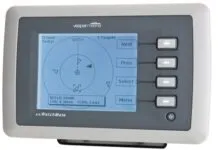
Vesper Marine WatchMate 850 and Icom M91D: Where Credit is Due
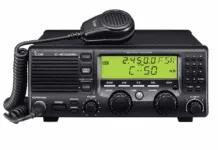
How to Create a Bullet-Proof VHF/SSB Backup

Tips From A First “Sail” on the ICW
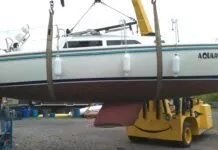
Haul Out Tips to Avoid Confusion and Delays

Checking Rope Strength
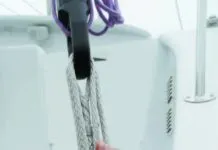
Lashing for Strength

Are Wrinkles Killing Your Sail Shape?

Ensuring a Safe Space for Batteries
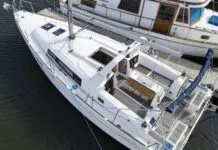
Impact of Modern, Triangular-Design on Boat Performance
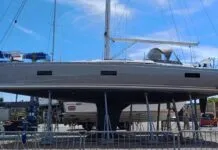
Keel and Rudder Design Basics

Diesel-Electric Hybrids Vs. Electric: Sailing’s Auxiliary Power Future

Wooden Boat Revival: Can Boatbuilding Be Regenerative?

How to Make Dodger Cover Canvas Pattern

How Much Does It Cost to Keep a Boat on the…
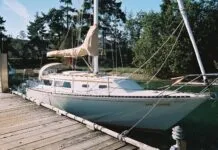
Insurance For Older Sailboats

PS Advisor: Acid Cleaning Potable Water Systems

Product Hacks: Velcro, Bounce, Anti-Skid Mats and Pool Lights

Stopping Holding-tank Odors

Giving Bugs the Big Goodbye

Five Best Cheap Clothing Options for Cold-Weather Sailing

How to Scuba from Your Boat

Compact Scuba Kits for Sailors

Cold Weather Clothes to Extend the Sailing Season

Bilge Pump Installation and Maintenance Tips

Full-Time Ocean Trash Cleanup in the Arctic Circle

Boats That Fly? How High Tech Rocked the America’s Cup

R. Tucker Thompson Tall Ship Youth Voyage

On Watch: This 60-Year-Old Hinckley Pilot 35 is Also a Working…
- Belowdecks & Amenities
The Galley: Where Form Meets Function
Ps asks cruising cooks and chefs: what makes an ideal sailboat galley.
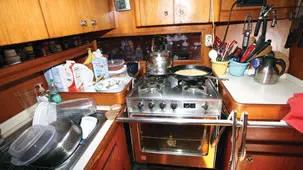
Cooking a great meal in a cavernous kitchen outfitted with every imaginable culinary device can be difficult enough, but doing it in the confined space of a sailboat presents greater challenges, some the result of ill-conceived galley layouts.
But what makes up a dream galley for cooking underway? To find out, Practical Sailor interviewed full-time chefs working aboard sailboats as well as cruising sailors who have experienced first-hand the challenges of putting together a meal in a pounding sea. (For links to our past tests of the galley gear described below, check out the online version of this article.)
In the book “Desirable and Undesirable Characteristics of Offshore Yachts,” published in 1987 by the Technical Committee of the Cruising Club of America, the authors noted that before 1970, a galley was located anywhere on a boat. Since then, however, the most typical location has been next to the aft companionway, where it is less susceptible to violent pitching motion and makes it easy to pass food from the galley to the cockpit.
Most of the galley chefs we spoke with agreed that the best place for a galley is amidships or aft. A galley too far forward takes the brunt of foul weather, turning utensils and appliances into safety hazards.
“Being forward is tough,” said full-time sailing chef Jade Konst of Vancouver Island in British Colombia, Canada. “You are constantly bucking the waves.”
She recommends outfitting a galley with cupboard shelves that pull out on sliders or have a rotating lazy Susan, making the contents easily accessible. All cupboards should have locking latches to ensure that they don’t come open unexpectedly, and a pegboard system of vertical dowels helps hold mugs and cups in place, she added.
Other suggestions from the chefs: more counter space; wall-mounted racks with fiddle rails to keep spice bottles safe but accessible; and fiddles around preparation counters that aren’t so high that it’s difficult to chop ingredients (chopping at a steep angle can lead to wrist pain).
Our chef-designed ideal galley also would feature grab rails or handles bolted to the galley ceiling, bulkheads, and at strategic places near the stove. Galley stoves must be gimballed and have pot clamps. We recommend beefing up the standard, tab-style gimbal brackets on boats that voyage offshore. (Learn more about bulletproof stove brackets and our top picks for galley ranges in the July 2007 test report.) The oven doors should be secured with a heavy metal bar that can be lifted to access to the oven.
Professional galley chefs prefer stainless countertops because they are easy to clean and are impervious to scalding from hot pans, but they are a rare find on cruising sailboats. However, an integral counter-top butcher block—or a set of smaller cutting boards stowed in a latching wall rack—are galley necessities.
None of the chefs interviewed use a webbing system or restraining belt to secure themselves near the stove in heavy weather; however, some form of a tether system for the cook is always a good idea, in our opinion.
The cooks overwhelmingly preferred double-basin sinks that are at least 8 to 10 inches deep to ensure dishwater and dirty dishes stay in place. This also allows washing in one side while rinsing in the other, minimizing water usage.
Sinks located on the centerline are ideal because they will drain on either tack, whereas outboard sinks tend to become useless on one tack. Deep stainless sinks also offer a good place to rest hot pots to keep the contents from spilling.
The well-equipped cruising boat should also include a manual galley pump , or saltwater foot pumps ( PS , Oct. 1, 2002 ). They help conserve freshwater and come in handy if the electric water pump fails. ( Practical Sailor’s test of electric freshwater pumps appeared in the May 2011 issue.) And if water purity is a concern, we’ve done a series of articles on testing, treatment and filtration, and all of them are compiled in our four part e-book series, Onboard Water Treatment, Storage, and Production .
It was collectively pointed out that sailboats are primarily designed by men, many of whom do not cook and have only marginal interest in what goes on in the galley. As a result, many galley designs are afterthoughts. For example, several boats Practical Sailor examined had a pass-through galley design, which made things particularly difficult during meal preparation. On one such boat, foot traffic was an ever-present nuisance because the V-berth was located on one end of the galley, the main saloon on the other. This led to abundant exclamations of “excuse me, excuse me” as crew and the cook maneuvered in tight quarters. On the same boat, the doors of the front-loading freezer and refrigerator opened into the narrow passageway, making it impossible for anyone to get by until the doors were closed.
Ventilation was also a hot topic among those who regularly slave over galley stoves. All recommended installing electric fans, a hatch, or at the very least, a dorade.
The Social Galley
Recent yacht design has emphasized placement of the galley so that the cook(s) can socialize with those in the main saloon. On a small boat, where dinner might be service for four, this arrangement can work nicely. But some chefs would rather concentrate on making dinner instead, and waiting until dinner is served to join the conversation.
“There’s a lot of movement when you are under way,” explained chef Jane Ireland. “Add people to that, and it can be like a game of Twister in here.”
Megan Puorro, a Texas native working as a full-time onboard chef, said, “There are times when I don’t want to socialize. I want to make dinner. It’s nice to be off to the side where if I want to join in, I can. But when the pressure is on to get a meal on the table, it’s a better arrangement when the galley isn’t on full display. ”
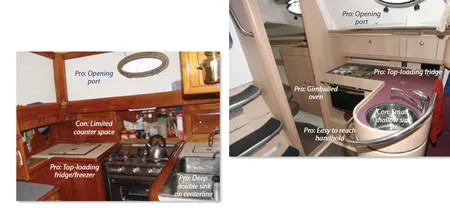
When it comes to safety, the cooks each had their own harrowing tale of microwave ovens, toasters, and coffee makers transformed into projectiles in rough seas. The rule: If the appliance isn’t built in, make sure it gets bolted down or otherwise secured while underway. This is a good practice even for lighter-weight kitchen gear like trash cans.
One of the more important safety items in a galley is the dry-chemical fire extinguisher (Class B, ABC, or B CO2). Putting water on flaming grease will only spread the fire, so keep an extinguisher close at hand and train crew how to use it before the need arises. And don’t forget to have a fire blanket. As we described in our test of popular galley fire blankets , these are one of the most effective tools for dealing with a galley fire.
In some galleys we toured, a magnetic strip was mounted on a bulkhead near the food-preparation area to hold sharp knives. Most cooks agreed that while the setup is convenient, the blades could shake loose in foul weather and pose a serious hazard. We don’t recommend this storage method.
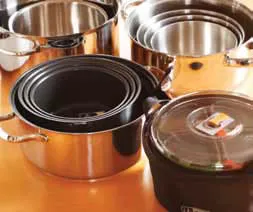
You can add efficiency to any galley with the help of a few appliances and accessories. Some favorites include an electric rice cooker, stainless-steel pots and pans, a pressure cooker ( PS , December 2010), cast-iron cookware, nesting cookware ( PS , April 2009), a thermal cooker ( PS , September 2012), and collapsible bakeware ( PS , December 2009).
Konst explained that a rice cooker frees up a stove burner, and if the burner flames keep blowing out, the rice can still be cooked. Boat chef Susanne Akerlumd suggested investing in stainless pots and pans with thick bottoms and snug-fitting tops—they can withstand the rigors of service on board, and tight lids keep contents from spewing all over the cook.
While a pressure cooker can save you time and cooking fuel, nesting and collapsible cookware save valuable storage space. Another storage option the cooks suggested was packing baskets with foodstuffs (plastic shopping baskets work well) and stacking them on unused bunks, secured with a line or lee cloth. Hooks can be used to hang bags of food. A few small food lockers are better than one large locker, where digging is required to find what you need and the contents scramble when the boat is sailing to the lee.
Interestingly, the cooks we interviewed had quite different opinions of what constitutes ideal galley refrigeration. Despite the inconvenience of having to lift the lid and dig deep, some professionals and most cruisers adamantly preferred top-loading freezers, contending the food stays colder for longer. Others criticized top-loading freezers, saying they attract counter-top clutter that must be removed before they can be opened. However, front-loading fridge/freezers have their downside too: They have less insulation and are real energy hogs when away from shore. (Find out more about galley refrigeration in our June 2009 review of ice-box conversion kits .)
The chefs agreed that the most important design feature of a galley is having the stove, sink, refrigeration, and food prep area in close proximity. In home design, it’s known as the 10-foot kitchen triangle, a concept that can be downsized to function on a sailboat.
Konst suggested boat designers create and test a galley mock-up before installing it. “The biggest question should be: How does the galley work under sail? Anybody can cook a meal with all of this equipment when the sea is calm.”
Chef Hakan Norberg summed up the necessity of intelligent galley design: “Food and sailing go together. They should be the same in importance.”
- Install a Water Saver
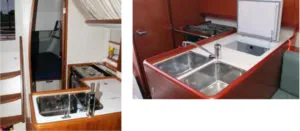
- Easily accessible oven and stovetop.
- Securely latching drawers and cabinet doors.
- Cabinets fitted with lazy Susan rotating shelves.
- Several small to medium storage lockers.
- Top-loading refrigerator and freezer.
- Twin-basin stainless sink at least 8- to 10-inches deep.
- Ample ventilation.
- Generous counter space.
- A slow-swinging, well-ballasted gimballed stove with pot clamps.
RELATED ARTICLES MORE FROM AUTHOR
Has PS ever reviewed/tested galley ventilation systems like the hoods most people have in their homes. I know there are marine companies that have made them for boats. If you have please refer to the article so I can look it up. Thanks for being a big help making our boats better and safer!
LEAVE A REPLY Cancel reply
Log in to leave a comment
Latest Videos

24 Knot Speed Trimaran – The Dragonfly 40 Ultimate

AMAZING Sailboat Drones, US Navy Deploys 65 Foot Sailing Drone

The SHOCKINGLY Comfortable Million Dollar Sailboat From Moody

New Sailor CRASHES and Needs Advice!
Latest sailboat review.
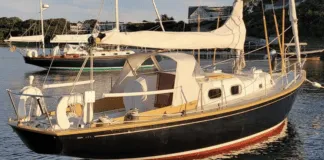
- Privacy Policy
- Do Not Sell My Personal Information
- Online Account Activation
- Privacy Manager
- BOAT OF THE YEAR
- Newsletters
- Sailboat Reviews
- Boating Safety
- Sails and Rigging
- Maintenance
- Sailing Totem
- Sailor & Galley
- Living Aboard
- Destinations
- Gear & Electronics
- Charter Resources
- Ultimate Boating Giveaway

Galley Klatch
- By Elaine Lembo
- Updated: July 28, 2010

beneteau galley 368
It started with sea water standing in the galley sink. Each time Gwen Hamlin and Don Wilson’s Tackless II, a CSY 44 walk-through, sailed on port tack, the sinks backfilled if someone forgot to close the through hull. At anchor, they gurgled. A macerator installed in the sink’s exhaust line solved that.
While they were at it, and considering that they were about to head out on a 10-year sojourn through the Pacific Ocean, they ripped out the old sinks and installed a new, deeper, stainless-steel double. They also threw in a household pull-out sprayer faucet, molded countertops that shielded the oak joinery from stains, and a cutting board that fit over one of the sinks and could be slid from side to side while the boat was under way.
Moving on, they converted a starboard hanging locker to hold canned goods, had custom nesting box shelves built in to hold onions, potatoes, and tomatoes, mounted a microwave under the cockpit deck, and set up electrical appliances on an inboard ledge.
That work doesn’t even take into consideration a massive redesign, repurposing, and repowering of the fridge and freezer compartments.
Just as Gwen and Don wouldn’t head off with tattered sails or a natty inflatable, they wouldn’t dare overlook one of the most important components of their liveaboard boat-the galley.
Their vision would score points with any number of designers, fellow live-aboards, and builders who’ve spent time focused on the galley’s critical role, no matter what size the boat.
The refits that cruisers have undertaken, as well as the observations made by industry experts about layout, innovations, and improvements over the years, yield a hefty platter of points to consider when you’re contemplating your own refit project or boat-buying prospects.
A Sense of Proportion On the other end of the spectrum is Brandon Somers. who lives in the seaport village of Wickford, Rhode Island.
Somers, who grew up aboard the beefy 63-foot Lemsteraak Dutch sailing barge Brandaris, has chosen to downsize as an adult. With his sights set on cruising among southeastern New England’s anchorages and islands on overnights and weekend excursions, the 24-year-old Somers is midway through a complete refit of the modest galley on his 28-foot Pearson Triton.
As the plumber and mechanic for Jamestown Boat Yard on Conanicut Island in Rhode Island, Somers did his homework by photographing interiors of Pearsons he liked and had worked on.
Among the problems in the old galley? The starboard length of the saloon was entirely countertop, the boat lacked needed shelving and stowage, there was no table, and the icebox, with access from the cockpit, wasn’t really usable.
Among Somers’s additions are a two-burner stove, an accessible sink and icebox, a dinette that seats two, and a pressure water system. He’ll use propane for the stove and construct a deck box at the mast to accommodate the fuel source. And he’ll make a cushion/bunk on the starboard side of the saloon. “You need a place to sleep amidships,” he says.
A sense of proportion and creating a space that’s useful yet convenient are in line with Somers’ priorities, and it’s a wise choice as a project, according to designers and builders of leading production models.
A Designer’s Eye Apply methodical thinking to your situation, urges yacht designer David Pedrick. Pedrick’s prolific career has yielded such diverse results as America’s Cup racers and superyachts, restored one-off classics, and successful production models, including the Freedom 35.
“As with anything dealing with yachts,” he says, “space is precious. There’s never enough. You have to prioritize how to use space in a desirable way.”
The choices grow proportionately with size. A 30-footer is very limited, a 40-foot-plus boat gives you more latitude for, say, a three-burner stove with oven, and by the time you’re considering a 60-foot boat, cul-de-sac shaped galleys aren’t out of the question, Pedrick says.
With each incremental growth in boat size comes a threshold at which you have to think twice before adding the next amenity, yet even in a 30-footer, “you still want a sink that’s big enough to hold a pot or a dinner plate,” he says.
As amenities start to include things like microwaves and pressure water, Pedrick says, “You realize that it isn’t just galley space you need. You need power capacity, too.”
Real People, Real Numbers Typical cruisers sail about 10 percent to 20 percent of the time and spend the rest on the hook or in a marina. That realization in the last 20 years is what has largely influenced galley innovations, says Bruno Belmont, Beneteau Group Sailboats Development Director. With that title, Belmont’s been involved with oversight of designs for a wide range of Beneteaus as well as sailboats from Lagoon and Jeanneau.
“People used to comment about their sailing vacation by listing the number of miles sailed,” Belmont says. Acknowledging that actual miles sailed may be less in some cases made it possible to change perspectives about what a cruising sailboat should deliver, especially in the galley. Results have ranged from improvements in countertop surfaces and material to larger, more practical sinks, stoves and ovens of usable size, properly located lights, and last, but not least, practical and more energy efficient refrigeration. According to Belmont, refrigeration is the second biggest energy drain on a sailboat, after belowdecks lighting. ( “Reefer Madness”)
Adding that “a long battle has raged for years between front opening and top loading fridges,” Belmont says the end result is a stroke for power efficiency: front opening compartments for the refrigerator, and top loading compartments for freezers.
As well, Beneteau designers have improved the ability to use the galley under way, focusing attention on handrails, fiddles, hanging bars, and stove protection.
Housebroken Though the galley has always rated key consideration in sensible yacht design, changes over the last 25 years on the domestic front are influencing changes in the galley design, says Gerry Douglas of Catalina.
“It’s similar to what’s happened in houses,” says the Catalina corporate vice president and head of engineering. “Years ago, the galley was utilitarian. In some boats, the galley counter was actually a companionway step. Sometimes the galley was in the peak-if you had a paid hand.”
In residential design, Douglas says, the kitchen in the last 20 to 25 years has become a social space. More people are focused on food and food prep as a social activity.
“Food also takes on importance in cruising, and now the galley is front and center in the main cabin,” Douglas says, referring to changes in such newer Catalina models as the 445. “The cook’s at the sink and has eye contact with other crewmembers. The cook’s now engaged, looking into the main cabin, not with his or her back to the social space. It’s subtle, but important.”
While trends borrowed from home design enhance the galley experience, borrowing too much from designs meant for living on land can yield regrettable trends, he says, among them, “odd angles that don’t seem to make sense.”
“The galley is an interesting space-a combination of aesthetics and function,” he says, adding that the G, L, and J layouts give cooks a way to brace themselves under way.
Douglas’s enthusiasm for accommodating food preparation doesn’t include acceptance of all modern-day conveniences, like watermakers and microwaves. “Watermakers are like electronics,” he says. “They’re always getting better, cheaper, and easier to operate. Don’t buy one until you really need it. Also, realize that having one isn’t dependent so much on the size of the boat, but how much you actually use the boat.”
And, as for microwaves, “they’re the world’s most expensive bread box,” Douglas says, expressing his personal view, as microwaves are a feature that Catalina offers.
A Movable Feast Island Packet founder and designer Bob Johnson has a simple, direct way of expressing his priorities for the galley.
“If you’re going to cook a meal on a boat,” he says, “it should be like cooking a meal at home. Eating granola bars and drinking bottled water for days is not the way you want to go.”
That opinion and all it implies has guided the highly successful galley walk-in and walk-through variations Johnson has created for IP hulls in the 30 to 50 foot range. Besides the larger center cockpit models freeing up belowdecks space and sight lines nicely for the galley, while allowing “amazing walk-through space between counters,” all IP galleys, whatever the length, “must have working space for real people and all the safety considerations,” Johnson says.
And regardless of the make and model, even on a 30-footer, Johnson says, you need stowage for cutlery; dishes; dry storage; a good icebox either of one or two compartments; and a two-burner stove.
Expanding on signature must-haves (see his list), Johnson explains what goes into his thinking when it comes to the designing of IP galleys.
“It’s nice to be able to find the oil, have a place to chop vegetables, have the spices within reach,” he says. “I prefer to dry dishes and let them nest. You need a stove with a good oven. You need to be able to operate it safely, so it needs to be gimballed and you need to be able to strap yourself in with a harness. You can put a very large pot under the gimballed stove.”
And Johnson agrees with Catalina’s Douglas that the best in home-kitchen design can also find an appropriate corollary afloat. “Like a house, the galley is the central gathering point,” he says, noting with irony, “I eat better when I’m sailing than I do at home.”
“As a designer, cruiser, and onboard cook,” he says, “and knowing owners who enjoy cooking on board, it’s practical to consider these points.”
He Wrote the Book When Donald Launer got to his 17th sailboat, the bare fiberglass hull of a schooner, and was faced with constructing everything from scratch, he went looking for advice in his vast nautical reference library at home in New Jersey.
He couldn’t find much of anything written about galleys, either new or refit. The Galley: How Things Work ($18; 2009; Sheridan House) is his way of filling that gap, by documenting everything he did. It’s a thorough compilation of galley infrastructure and resources, materials choices, and galley hardware, from types of water tank materials to stoves, fuel, pumps, electrical requirements, as well as construction considerations.
“I had experience in putting things together,” he says. “It seemed appropriate to help others who were either modifying or building their galleys from scratch.”
Galley Classroom “Before you go cruising, it’s hard to imagine exactly what it will be like,” says voyager, author, and website creator Kathy Parsons.
“The galley is a real important part of the boat and a segue to learning about other things, like refrigeration and plumbing. This is a really great way for women to transition into the cruising life,” she says.
Besides creating the Women and Cruising website ( www.womenandcruising.com ) to address resources geared to female crew, Parsons interviewed 18 women solely about galleys. The result is a gold mine of advice and ideas about provisioning, what works when living aboard, what doesn’t, what they like, and what they’ve changed.
Many of the women, like Hamlin of Tackless II, undertook extensive refits and in at least one instance, design, aboard a variety of boats, from a 46-foot Crowther catamaran to a Whitby 42. Even in the most minimal of projects, recurrent themes and a few surprises emerge. One woman, a professional interior designer and the co-owner of the Crowther, lofted the galley on paper and then made a plywood and cardboard mockup to test usability of the new layout.
Aside from that owner, most of the women are aboard used boats. Their liveaboard priorities are strikingly in line with those of builders and designers of new boats: better, more efficient, front-loading refrigeration; more and accessible stowage; more counter space made of durable materials; roomier walkways to accommodate more than one person; stronger lighting and additional ventilation; range/stove hoods; filters for water taps; pressure water systems; eye contact with other crewmembers while cooking; and double sinks.
The main element of surprise is that these liveaboards, no matter what size the boat, altered galleys to accommodate a host of electrical appliances, particularly, microwaves. Read each woman’s account carefully and realize that a range of personal preferences and divergent opinions also emerge and influence their work. You’ve gotten a taste of valuable insights into galley refit and design. There’s only one thing left to say: Bon appetit!
CW deputy editor Elaine Lembo has earned her keep working in galleys luxurious and rudimentary throughout New England and Caribbean waters.
- More: DIY Sailboat Projects
- More How To

Striking the Balance: Comfort, Complexity, and Accessibility

Cruise Control: Heavy Weather Sailing Advice

Sailing Totem : One Nice Thing

Pain Is the Ultimate Teacher: Hard Lessons in Seamanship

Cruising with Confidence: How Modern Boats Are Measuring Up

Sailboat Review: Dragonfly 40

Sailor & Galley: Easy Pink Aioli Dip

Reefs at Risk: How Cruisers Can Champion Ocean Conservation
- Digital Edition
- Customer Service
- Privacy Policy
- Terms of Use
- Email Newsletters
- Cruising World
- Sailing World
- Salt Water Sportsman
- Sport Fishing
- Wakeboarding
- Skip to primary navigation
- Skip to main content
- Skip to primary sidebar
- Skip to footer
Yacht Cruising Lifestyle
Everything fun you can do from your yacht
Setting Up the Perfect Boat Galley
March 19, 2021 by Travis Turgeon Leave a Comment
Living on a boat comes with countless challenges, but few can cause more frustration than a poorly designed galley. It’s tough enough to cook a great-tasting meal that everyone enjoys in a standard kitchen, but managing that in a swaying, confined space with limited resources can make you want to hurl yourself overboard. A perfect boat galley is well-designed, highly functional, and safe to use. Below, we cover everything you’ll need to know to make the most out of your space.
The Boat Galley
Boat galleys vary in a ton of different ways. Size, layout, storage, proximity – the list goes on. Each boat will require a slightly different setup than the next, but certain features are beneficial across the board.
Boat Galley Basics
Boat Galley Location
From cooking and cleaning to remaining mobile and social, the location of a galley can dramatically impact your culinary experience at sea. The galley should be accessible from both the cockpit and saloon, well ventilated and in an area that is less prone to boat roll than other areas. Placement at the foot of the boat’s companionway is ideal, as it satisfies the three considerations mentioned above. Those with multiple roles on the boat will enjoy this location as they make trips above and below deck. Each boat will have a different setup, though, so be sure to consider the specifics for you and your crew. What works for some will be less than ideal for others.
Boat Galley Layout
The shape and layout of your space will dictate how you set up your kitchen and arrange your boat galley accessories. Three standard layouts for a boat galley exist – Linear, L-Shaped, or U-Shaped. L-Shaped and U-Shaped galleys are more commonly found on offshore cruisers, as the design provides more support and security when the boat is rolling. They also keep spaces and cooking accessories nearby for a busy evening as the lead cook.
While these confined layouts are more suitable for safety and convenience, they reduce the overall ability to be creative in the kitchen. Less space means you have to be more mindful of the equipment you’re using, as well as how many dishes you can prepare at once. It would be best if you determined your galley’s layout by evaluating how many people are on board, how often you’ll be cooking during open-water passages, and how creative a cook you are in the first place.
Functionality
Gimballed Boat Appliances
A gimbal is a single-axis support system on which objects pivot to stay level, even when their surroundings are not. Having gimbaled boat appliances is essential to cooking safely, especially when making long passages in inclement weather. The most common boat appliance to mount on a gimbal is a stove and oven. Gimballed boat appliances are lockable when not in use, so you can use the equipment as usual when at anchor or docked in the marina.
Logical Refrigeration Placement
While modern boat galleys are becoming more logical in their design and layout, there are often things that leave us scratching our heads when looking at older vessels. Unfortunately, one of the most common issues we see is the placement of refrigeration and freezer units. Whether due to space restrictions or simple neglect, we see these cooling units installed near engine rooms, ovens, or in areas with minimal ventilation. For obvious reasons, placement in these areas will drastically reduce energy efficiency and drive up costs. When looking to buy a used boat or renovate your existing galley, make energy efficiency a primary consideration.
Boat Galley Convenience Features
Double-Basin Sink
While this is, of course, a subjective opinion, many offshore cruisers prefer to equip their boat’s galley with a deep, double-basin sink. Deeper basins offer a few advantages, although not every person will see them as essential.
The main advantage is the ability to soak your dishes without worrying about water overflowing when the boat rolls. However, if you’re only cooking for a few people, you can manage this with a shallow sink as well. The selling point for most is the double basins. With two basins, you can use one for washing and draining while the other serves as a soaking station. After all, efficiency is the name of the game in such a small and limited cooking space. If you aren’t using one of the basins, you can increase your counter space by placing a fitted cutting board or surface over the second basin. Depending on the meal, you may require more space or an assistant in the kitchen.
Locking Cupboard, Drawer, and Oven Latches
Installing lockable latches to anything with a swinging door or a sliding drawer is the best way to prevent things from coming open during a passage. Not only are you risking breaking your kitchenware, but you’re potentially turning ordinary household items into dangerous, high-speed projectiles. These latches are cheap, easy to install and provide peace of mind for a more relaxed journey.
Vertical Cupboard Dowels
Another infinitely helpful boat galley accessory is vertical dowels, installations to keep glasses in place and prevent breakage. You can also use dowels to stack plates and bowls, although most find the best use for them to hold their precious wine glasses and beer mugs. Ensure you won’t be drinking your wine from plastic cups by installing these boat galley accessories in your cupboards.
Wall-Mounted Racks
Having wall-mounted racks in strategic locations around the galley can help the chef stay organized and uncluttered without sacrificing accessibility for items like oil and spices. If your wall rack doesn’t have a security band or horizontal dowel to keep items secure, you can easily install a bungee cord to keep things from moving around.
Boat Galley Safety Features
Grab Rails and Handles
When it comes to the boat galley, you need to consider safety a top priority. If not, you’ll quickly find out why this is such a pressing matter. One of the biggest threats to a cook is the prospect of being tossed across the galley. One of the best ways to prevent this from happening is by having handles and grab-rails within reach, although some prefer tether systems. The debate will likely continue through eternity, but most long-term cruisers seem to prefer handles and grab-rails as it keeps them mobile in case of emergency.
Tether System
Depending on who you ask, tether systems that hold a cook in place are extremely useful or extremely dangerous. Most seem to think they are more dangerous than beneficial, but those with knee or back injuries may find them invaluable in keeping them stable and safe in the kitchen. When cooking on a boat during a rough passage, being tied in place directly in front of hot liquids, fire and pans can be dangerous. If any of those things spill in your direction, burns and bruises are sure to follow. Handles and grab-rails are a common alternative to tether systems, but debates on a better design can become heated depending on who you ask.
Boat Galley Upgrade Considerations
Another method to improve refrigeration efficiency is to create an “organization plan.” Installing shelves and drawers will help with organization and space efficiency, and using color-coded labels can help with the quick identification of any item.
Hand and Foot Pump Faucets
Using your freshwater supply to clean dishes is far from economical, so installing a hand or foot pump to the faucet is a great way to minimize the use of your limited resources. Cleaning your dishes with seawater is not only easy, but the resources to do so are completely free. You can arrange hand pumps and foot pumps however you prefer, but a common method is to hook a hand pump to freshwater and a foot pump to seawater. Just clean your dishes with soap and saltwater, and give a quick rinse with fresh water to conserve your onboard resources. You can take the conservation efforts a step further by filling a spray bottle with fresh water to rinse dishes. Although a hand or foot pump uses minimal water, a spray bottle uses even less.
Stainless Steel Boat Appliances
Everything from your kitchen sinks to refrigerators and stovetops is subject to deterioration from salt while at sea. Most new vessels come equipped with all stainless steel appliances for just that reason, but certain models cut costs by supplying the galley with boat appliances made of other materials. If you have boat appliances or kitchenware constructed with anything other than stainless steel, it’s worth considering an upgrade. By spending money on items constructed with high-quality material now, you can avoid higher-cost replacements down the road.
Boat Galley Lighting
Poor lighting in your boat’s galley can create a dull and uninspired atmosphere, so upgrading your existing lights to LEDs can help liven the mood. Apart from your mental health, LEDs are far more efficient than standard bulbs, which reduces long-term energy costs. Consider installing additional lights to areas above the sink, stove, or countertops. Some LED lights can switch from red to white light, which is beneficial when setting the appropriate mood.
Port / Hatch Enlargements – Ventilation
Your boat’s galley is the space that needs the most ventilation – for comfortability, safety, and health. When cooking on a boat with propane, it’s crucial to have a well-ventilated kitchen space. Natural gases tend to be denser than air, which means that the gases will “fall” beneath the lower deck if a leak goes unnoticed. Once below deck, the heat can cause combustion to occur, endangering everyone on board or near the boat. Improper use of propane has killed and injured many cruisers in the past, so be sure to prepare appropriately if you decide to use propane as a fuel source. On that note, install gas monitors for further protection.
Galley Cookware and Accessories
With a small amount of planning and preparation, cooking on a boat in a small galley can be enjoyable. Some of the most important considerations to make are the essentials and non-essentials for kitchen cookware and boat galley accessories.

Boat Galley Essentials
Pressure Cooker
Pressure cookers are the perfect answer to your multi-purpose needs in a boat kitchen. With the steam vent left open, a pressure cooker serves as a standard pot for all daily meals you would prepare in a kitchen at home.
Closed, your cooking time decreases drastically, making those long-haul passages in inclement weather nothing short of a breeze. Although most people who venture into the cruising lifestyle don’t have a ton of previous experience with pressure cookers, the learning curve is exceptionally shallow. You can master it in nearly no time.
Nesting Pots and Pans
Dual-purpose kitchen cookware covers all of your bases without stocking up on too many unnecessary items. Further, having nesting cookware is the key ingredient in keeping storage space efficient and uncluttered. Simply put, nesting cookware cascades in size, allowing you to stack each item inside one another. Once you clean them, stack them together, and viola – efficiency at its finest.
Tin Foil and Freezer Bags
Two of the most challenging items to find in foreign countries, whether in the south Pacific or the Caribbean, are heavy-duty tin foil and freezer bags. Keeping your perishables fresh and delicious becomes extremely difficult without the proper boat galley accessories, and these two items are at the top of the list.
Anything and Everything Silicone
Silicone products are a full-time cruiser’s best friend, making life easy in a variety of ways. Silicone mats allow you to bake without using oil or parchment, are easy to clean, save on storage space, and provide slip-resistant surfaces for any area in the galley. Collapsible mixing bowls and measuring cups are unbreakable, light, and space-efficient.
Almost all silicone kitchen items can serve multiple purposes, as they are heat resistant, soft, and have gripping properties. Not only are silicone products highly functional, but they are also stylish and colorful – bringing even the dullest of kitchens to life.
High-Quality Knives
Having just a few high-quality, sharp knives on board makes a world of difference for the seasoned chef. In this case, quality over quantity has never been so important. Stainless steel material is the go-to in saltwater environments. High-quality knives make it easy to serve multiple purposes without sacrificing storage space or functionality.
Boat Galley Storage
Living on a boat will turn even the messiest of us into overly neat and well-organized human beings, but this only happens through trial and error without proper direction. Luckily, information is right at our fingertips these days.
Dry Storage
Storage Hammocks
Keeping dry goods such as fruits, vegetables, and spices in a storage hammock is a great way to conserve your cupboard space in the boat galley. Storage hammocks are just what you would imagine them to be. They are small, mesh nets that hang as a hammock does above your sink or stovetop – just try to keep them out of the way of cabinet doors and drawers.
Many experienced boat cooks keep the essential items here for easy access and quick use while preparing meals. The hammock swings just slightly when sailing through rough seas, but they are far from a nuisance if you install them in an ideal location.
Rotating Cupboard Shelves
Instead of pulling out every spice jar to reach the back of the cupboard, install a rotating shelf to make life easier on yourself. Emptying your whole cabinet during passage is a huge inconvenience, and keeping everything secure can become a hassle. You can install rotating shelves as multi-tiered vertical fixtures, so you can use each shelf to organize in a sensible way for your galley.
Refrigerator Storage
Knowing What Needs Cooled
Not all foods need cold storage for safe consumption. Having a good understanding of which items in your kitchen need cooling will save you space and energy, so familiarize yourself with the requirements of the foods you keep onboard.
Grains, rice, flour, fruits, vegetables, and many other items sealed in jars don’t need cooling for healthy consumption. Follow this LINK for estimated keep times of various food items commonly held on a boat.
Top-Loading Refrigerator
Generally, top-loading refrigeration units are open and empty spaces without bins or trays for a personalized organization. When people first try to figure out the best way to organize their cold foods, they often just stack things wherever seems easy and convenient. For most, this leads to developing bad habits that ultimately cost them money as they continually reduce their energy efficiency. We recommend using dividers, trays, and compartments to organize. Over time, you will learn to optimize your storage space – making life less stressful in the galley.
Freezer Storage
Color-Coded Mesh Bags
Having a storage system for your frozen goods is the best way to minimize the time that the freezer door stays open for unnecessary reasons. A standard method for doing this is to have color-coded mesh bags to store frozen items. When looking for fish, poultry, vegetables, or anything else, having a color system reduces time spent fumbling through storage looking for something specific.
Freezer Placement
When buying a new or used boat, your cooling units will likely already have a home. If you’re planning to replace or upgrade your freezer, however, install it below the waterline for a lower ambient temperature – this will help with energy conservation, especially in warmer locations like the tropics.
Keeping Pests Under Control
Cardboard and Paper Labels – Cockroaches
Cockroaches are among the biggest nuisances on a boat, especially when stocked with long-term provisions. Small spaces between cardboard mesh and underneath paper labels are the ideal breeding ground for cockroaches – the reason behind most boat infestations. Some cockroaches species carry egg capsules inside their bodies, and before dying, they release dozens of offspring. Getting rid of cockroaches is extremely difficult if not identified promptly. When provisioning, your best bet is to entirely remove any paper or cardboard from every item before placing your goods into storage. Once you remove the labels, use a permanent marker to indicate the contents of the container. Instead of using cardboard boxes as storage, invest in hard plastic tubs and trays to minimize the otherwise continuous battle. Air-tight bins and plastic bags are low-cost and efficient in keeping cockroaches at bay.
If you find yourself with cockroaches scuttling across your floors, you need to act quickly. While there are dozens of strategies for clearing your boat, each will require a different approach. Some cockroach species are easier to eradicate than others, and it seems that everyone has different results with the same methods.
Your best bet is to employ several of the following simultaneously:
- Cockroach Gel-Bait
- Poison Powders
- Fumigation When Necessary (this method requires you to vacate the vessel for 48 hours and remove any cookware, cutlery, and utensils beforehand)
Air-Tight Plastic Storage – Weevils
Weevils are another common onboard pest, and they can be majorly destructive to your provisions. Food items such as rice, nuts, flour, and beans can become infested quickly if not correctly stored in air-tight plastic containers. These foods act like magnets for weevils, and they are the perfect breeding ground for their nearly unnoticeable larvae. Even when treated with pesticides, things like flour provide the ideal habitat for weevil larvae to flourish.
If you are unfortunate enough to open up your grain or flour containers to find weevils, there are a couple of tried and true ways to get rid of the infestation. For flour, simply microwave the product for five minutes or longer, or bake it in the oven at 200 degrees F for 30 minutes. After heating, let cool before storing in an airtight plastic container and store with bay leaves to repel future weevils. For food items such as grains or nuts, you can place them in a deep freezer for several hours to several days. For the freezing method, you need to have a freezer that reaches temperatures well below freezing.
Keeping Clean – Ants
Whether on land or at sea, ants are among the most common pests in a kitchen environment. Sugary drinks, crumbs, and unattended spills are all reasons for ants to come aboard, so clean diligently everywhere on the boat – not just in the galley. You should take preventative measures before you ever see a single ant on the boat to ensure that a full-blown infestation doesn’t occur. Once ants make their way on board, you need to eradicate the problem at the source.
Preventative measures include:
- Creating Barriers on Dock Lines (Petroleum Jelly)
- Strategically Placed Ant Traps and Poisons in High-Risk Areas
- Whole or Ground Cloves Placed Near Sugar Containers
- Keep Sugars, Syrups, Honey, etc. in Sealed Plastic Bins
You can manage an existing ant infestation in various ways, although using several of the following methods at once is e asy and effective:
- Poisons (Borax and Sugar Mixture)
Galley Cookbooks
The Boat Galley Cookbook: 800 Everyday Recipes and Essential Tips for Cooking Aboard, by Carolyn Shearlock
The space is tight, the ingredients are limited, and you just caught a fish you’ve never even considered preparing before. The boat-friendly recipes and tips in this book are sure to help out any long-term cruiser in the galley, but especially the unseasoned, first-time liveaboard chefs. In some parts of the world, chickens come whole, fish come uncleaned, and you need bones for your broth. Making bread and yogurt can also be a daunting task with limited resources. Taking raw, simple ingredients and turning them into full-blown authentic dishes inspired by cuisines worldwide is easy with this galley cookbook. Make sure this book is onboard – you’ll find plenty of uses for it.
Feasts Afloat: 150 Recipes for Great Meals From Small Spaces, by Jennifer Trainer Thompson
This book addresses one of the biggest problems with cooking on a boat, and it mentions it directly in its title – limited space. While other boat galley cookbooks try to create complex recipes with unusual ingredients and specialized cookware, this book takes a different approach – bringing you straightforward, easy-to-cook meals without sacrificing taste or quality. You can cook a new boat-friendly recipe from this book every day for nearly half a year, although you are sure to find a few weekly staples along the way. The printed, high-quality color photos inspire the boat chef and create a mouthwatering appetite for everyone on board. If you only keep a couple of cookbooks on board, this should be one of them.
* For a complete list and description of our favorite books to help you plan, prepare, and execute a life of cruising, follow this LINK !
Galley Tips and Tricks
- Before preparing a meal, take out every ingredient you’ll need and situate them in a way that will maximize workflow. Fumbling through your cramped and limited storage becomes frustrating when you need something at a moment’s notice.
- Decide on the items you find most useful, and make sure you have them with you – even if it means sacrificing a bit of storage space. If you eat vegetables with every meal, you can reduce the time spent in front of your cutting board by buying a heavy-duty hand dicer. If you’re a skilled fisherman and eat seafood often, having a vacuum sealer can be a lifesaver. Tailor your kitchen equipment directly to your needs, rather than using the “blanket method” for preparation.
- If you don’t have silicone mats, use damp towels to prevent plates and bowls from sliding across surfaces. You can take this idea a step further by applying a small amount of rubber cement to the bottom of plates and bowls. Once dried, few materials will grip surfaces more tightly.
- Wear a full-length apron to ensure that you won’t suffer burns if hot liquids spill as the boat rolls during passage.
- Old tube socks serve as excellent protection for precious wine and liquor bottles. Some will choose to invest in proper fixtures to make sure breakage does not occur, but you can just as easily prevent this from happening with towels and socks.
- When preparing freshly caught fish, the smell on your hands may linger for hours or even days. Washing your hands with vinegar is a sure-fire way to get the odor off right away.
Want to join the new forum at #BoatLife? Get a conversation started by leaving a question or comment for the community!
If you found this article helpful, please leave a comment below, share it on social media, and subscribe to our email list.
For direct questions and comments, shoot me an email at [email protected]
Sharing is caring!
Reader Interactions
Leave a reply cancel reply.
Your email address will not be published. Required fields are marked *
Save my name, email, and website in this browser for the next time I comment.
MB #20512 PO BOX 480 Sevenoaks Kent TN13 9JY
Tel: +44 56 0386 9163
Keep In Touch
Thank you for reading.
Join our online crew and find more about the #boatlife
Yachting World
- Digital Edition

Boat galley accessories: essential cooking tools for cruising sailboats
- Nica Waters
- April 7, 2022
After 30 years trying out various boat galley accessories, long-term cruising sailor Nica Waters offers her top recommendations for kitting out your sail boat's kitchen with a few tried and tested items from our Tech Editor Fox Morgan's Dehler 36 galley…

A well founded boat galley with just the right accessories for your food prepping style can make life on board an absolute joy.
Nica writes “We recently rebuilt the galley on our 28’ cutter, Calypso , the boat we’ve owned and cruised intermittently on since 1992. This time, using the wisdom gained over the past 30 years, we incorporated more usable storage areas, installed a large undermount sink, and even splurged on Corian counters.”
“As we moved aboard in April of 2021, we made sure that the galley items we brought with us are all ones we love and use frequently. After all, having the right tools makes cooking even more of a pleasure.”

The Marine Tech Editor, Fox Morgan loves their linear galley as it is especially well organised with just the right bit of kit in just the right places.
“Working in a confined space with limited storage, it’s a balancing act to make sure you have enough galley kit on board and don’t lack things that would make your life easier. Being judicious about what comes aboard can pay off handsomely both in terms of organization as well as the sense of space. For example, despite being a self-proclaimed cutting board addict, I had to be honest and realize that most of the time I use the same board over and over. I don’t need to take 15 on the boat! Almost everything needs to serve double duty; almost nothing is single use.”
If you’re just setting up a galley on the boat, here are some boat galley accessories you might not have thought of…
Boat galley accessories – knives
At the core of a good galley is its knives . You do not need to buy a complete knife set, which often include a number of knives you don’t need, but rather buy individual ones.
A 9” (or 7”) chefs knife, a serrated blade for cutting bread, and a smaller paring knife are essential; the next one I’d get is a long bladed boning knife for filleting your fresh catch of fish.
Find knives that fit your hand and feel good; some people prefer heavier ones while other people like light blades. Stainless steel blades will dull faster than carbon steel blades, but carbon steel blades will rust. Ceramic blades hold their edge for a long time but are notoriously hard to sharpen.
ZWILLING Chef’s Knife, Blade length: 20 cm, Wide blade, Special stainless steel/Plastic handle
A chef’s knife is an absolute must, ideally you’ll have more than one of these. As a boat galley accessories go, this is an area not to be scrimped on. Buy good quality. There’s a chance it will also be used for cutting and trimming lines on deck at some point too.
Price £63.84
Buy Zwilling paring knife from Amazon.co.uk
Shop for Zwilling knives on Amazon .com

ZWILLING Twin Pollux Bread Knife, steel, Silver/Black
A bread knife is one of the staple boat galley accessories, you might be cutting bread with it… sometimes it’s useful lashed to a pole for lopping a rope off your propeller too. Make sure you buy a good one of these!
Price £30.95
Buy Zwilling bread knife via Amazon.co.uk

Ceramic Blade Paring Knife with Sheath
Tech Editor, Fox Morgan says “Onboard Boogie Nights there’s two paring knives. One steel the other is ceramic and 9 times out of 10 I’ll reach for the ceramic blade. It is light and I like the white blade. It is SUPER sharp and I have already sliced the tips of my fingers off when not paying attention chopping an onion one day while distracted and chatting with my co-skipper. The blade protector stays in place and the knife lives in the cutlery drawer with other stuff. It’s a few years old now but still sharp and still my first choice from the drawer. It’s also great for slicing mooring lines for splicing or repairs. watch out for the super sharp blade really near the handle though. That can catch you out”

Food prepping in the cockpit on a very hot day. Ceramic paring knife in hand. Look carefully, they can be difficult to see with their white blades. They do come in brighter colours, I would recommend trying a bright colour for safety.
Price: £16.99
Buy Ceramic paring knife from Amazon.co.uk
Note: We may earn a commission when you buy through links on our site, at no extra cost to you. This doesn’t affect our editorial independence.
Having chosen your knives, you need to have a place to store them safely, and a way to sharpen them. One of our galley upgrades was a pair of magnetic knife strips which we’ve attached to the underside of the deck in the galley area.

under counter magnetic strip – doubled up for extra security
You do need to make sure these powerful magnets are placed far from any compass or autopilot. We have two strips so the knives are secured in two places along the blade. Our stainless steel knives hold well, which is an indication of the quality of the stainless steel they are made from. (note from Tech Ed: beware that some stainless blades are not fero-magnetic due to their metal composition. So double check this if buying new blades and intend yo hang them safely on magnets.)
MIU France Stainless Steel Magnetic Knife Bar, 15-Inch
Price: £32.87
Buy the MIU France Stainless Steel Magnetic Knife Bar on Amazon
If you store your knives in a general cutlery drawer, be prepared to sharpen them even more frequently as the blade edges will be .amaged and dulled by contact with other utensils, although some knives do come with blade protectors that slide or clip onto the knife blade to keep it tip top and to avoid accidental injury when reaching into the cutlery drawer.
A knife sharpener can range from a simple whetstone all the way up to an electric knife sharpener ; our preferred tool is an easy-to-use hand sharpener that guides the knife to the correct angle.

WORK SHARP Guided Field Sharpener
Price: £32.95
Buy Worksharp field sharpener via Amazon.co.uk
Chef’s Choice Professional Electric Kn ife Sharpener
Price: £217
Buy Chef’s Choice electric knife sharpener from Amazon.co.uk
Though this item possibly fails the ‘multi-use’ test, a Microplane zester is another must-have cutting tool in Calypso’s galley. Coming with its own guard, this slender rasp-style grater makes quick work of ginger, garlic, and parmesan cheese and stores flat; it’s also relatively easy to clean since you have access to both sides of the tool.
Microplane Zester Grater Black for Citrus Fruits, Hard Cheese, Ginger, Chocolate, Nutmeg and Truffle from The Premium Classic Series with Stainless Steel Blade
Price: £18.30
Buy Microplane Zester via Amazon.co.uk
Buy the Microplane zester on Amazon
Boat galley accessories – tongs
Everyone has their own preference as to tools to use to turn food in the pan. While spatulas and spoons, forks and even chopsticks all have their place in the galley, I can’t speak highly enough of these locking tongs .
OXO Good Grips Tongs – 12 inch
We have two pairs as we use them so much. One might be in use at the stove, turning meat or stirring pasta, while the other is being used to toss salad. I find the 12-inch size to be far more versatile than the longer ones, and personally find the silicone-tipped ones go gummy too quickly. Just be careful if using these with a nonstick pan surface.
Price: £27.99
Buy OXO 12-Inch Stainless-Steel locking tongs on Amazon
Colourworks Mini Tongs
These Mini tongs are useful in so many ways around the galley. You can pull a hot packet of wet food out of the the boiling pan with them or give a small pot a stir or flip your bacon with them. These fit into places where the larger tongs do not. Silicon tips can also help to preserve nonstick if you have that on your pans. Tongs of all shapes and sizes are considered one of the most essential boat galley accessories.
Price: £3.49
Buy Mini tongs from The Range
Boat galley accessories – blenders
Rounding out the hand tools category is an immersion blender .
When I lived on land, I used my beloved Cuisinart food processor almost daily. Space and power constraints on the boat mean it can’t come with us cruising, but I really did want something that could do some pureeing and fine chopping tasks.
A good galley alternative is an immersion blender. This stick blender does require an electrical outlet nearby, but fits into small spaces and larger pots with ease.
We call it the boat motor; it makes a lovely smooth vegetable soup as well making quick work of frozen fruit and yogurt for a smoothie.
The accompanying small bowl and blade means that smooth hummus and other luxuries are possible on board.
You can buy kits that come without some of the extra attachments (we in particular question the masher attachment), but they’re more expensive.
Braun MultiQuick Hand Blender
As used for over 10 years on the Tech Eds boat, this tried and tested hand blender has been pressed into action offshore many times, whipping up cake batters and chopping tomatoes and anything else we care to throw at it. One of the best value for money items ever introduced to the galley. It’s powered from a small inverter. Though, sometimes cake making goes a bit awry… sense of humour required when this happens. Thankfully we were moored up when this happened. This Braun hand blender was the secret weapon used in the great Atlantic bake-off during the Azab 2019 race.

utter carnage in the galley as the frosting went for a flyer.

Chocolate and Guinness cake, the SV Boogie Nights signature arrival cake, once we got the frosting in the right place it was utterly delicious and a doddle to make thanks to the little Braun gizmo.
Buy the Braun hand blender via Amazon.co.uk
Buy the Braun 4-in-1 Immersion Hand Blender on Amazon
Best pots and pans
Made-in stainless clad saute pan.
On board, I tend to cook with an eye toward cleanup. Like most cruisers, we’re water-conscious, and one way to minimize water use is to create fewer dirty dishes.
One-pot meals are a good way to put this mantra into practice. A surprise favorite pan for this is a stainless steel 3.5-quart saute pan (if we were a family of 4 still on board, I might like a larger version.)
This straight-sided skillet goes from stove top to oven flawlessly; the tight fitting lid for it means it can also work to cook rice or pasta. Watch for a handle that’s short enough to fit in the oven.
Price: £123.99
Buy the 3.5 quart Stainless Clad Saute Pan on madeincookware.com
Kuhn Rikon Duromatic Inox Stainless Steel Pressure Cooker with Long Handle, 5 Litre / 22 cm
Pressure cookers are another conservation tactic, working to save on cooking fuel as well as time spent in the galley. The premise behind these pots is that they cook foods at a higher temperature by applying pressure, meaning that cooking takes less time.
For example, if we decide at 5 pm that we’d like black bean soup for dinner; the pressure cooker takes beans from dried to yummy in half an hour. This pot doubles as my largest mixing bowl as well as a regular, non-pressurized pot for pasta.
Unfortunately, the Fagor brand we use has been discontinued, but this recommended one has been in use on my friend Behan’s boat for the past ten years.
Price: £132.53
Buy the Kuhn Rikon Duromatic Pressure Cooker on Amazon
Instant Pot Duo Nova 7-in-1 Smart Cooker, 5.7L – Slow Cooker, Rice Cooker, Sauté Pan, Yoghurt Maker, Steamer and Food Warmer
If you have the electricity and storage space to spare, multi-cookers (essentially, electric pressure cookers with a few other bells and whistles) are all the rage in the United States. I’ve never used one but have yet to meet anyone who is not wildly impressed. Many boats are shifting away from propane as a cooking fuel especially as lithium batteries are becoming more widespread, and a multi-cooker is a favourite boat galley accessory for cruisers with an electric galley.
Price: £69.99
Buy the Instant Pot Duo 7-in-1 Electric Pressure Cooker on Amazon

Tefal Ingenio Essential Non-Stick Pots and Pans Set, 5-Piece, Starter Kit
The Tefal Ingenio pans are also a boat galley favourite as they can go from stove top to oven to cool box and back again with their removable handles and clip lids to stop spillage.
The Tech Ed writes “These have been in use onboard SV Boogie Nights for around 8 years now.

Tefal Ingenio pans, with quick release handle removed for better balanced pans when sailing offshore. Stackable and versatile. An excellent investment for the galley.
The small frying pan is looking a bit tired because it get’s the most use but the clip handle, lids and pans are still going strong. The good thing is that you can buy the pans individually so you can make your own set that suits your particular galley needs. The handles are easy to find, often in European supermarkets too.”
Price: £56.99
Buy Tefal Ingenio starter kit from Amazon.co.uk
Best of the rest
Other favorite boat galley accessories and tools are personal: there’s the wide-mouth thermos I use to make yogurt, the citrus juicer I bought in an eclectic hardware store in the Dominican Republic, the French Press coffee maker we use every morning.

Zulay Metal Lemon Lime Squeezer – Manual Citrus Press Juicer
If lemons and Lime are your thing, then much like a garlic press, you’ll love this and it will make life just a little neater. Cocktails and cooking are a little bit better with a dash of citrus. The boat galley accessory you never knew you needed…
Buy Zulay lemon squeezer via Amazon

CLASSIC LEGENDARY FOOD JAR | 1.0 QT
A robust food flask with a wide mouth. Its ubiquitous design can be seen around the globe in the ditty bag of anyone who travels or wants to travel relatively light but head away from it all. This isn’t just a boat galley accessory, but a trekking and hiking accessory too.
Buy Stanley food flask via Amazon

Frieling USA Double Wall Stainless Steel French Press Coffee Maker with Zero Sediment Dual Screen
If you’re a coffee lover then a decent press will really enhance your mornings. Avoid glass and go for something sturdy, reliable and without consumable parts, such as paper filters. The dual mesh inner keeps the coffee grounds away from your cup and you’ll have enough in this press for more than one cup.
Buy Frieling stainless coffee press via Amazon

Luci Solar String Lights + Phone Charger with 100 Lumens
One special tool, although not a galley-specific item, that has immeasurably improved our dining life at anchor is these Luci string lights . Solar powered, they clip easily to our bimini top and provide light and ambience for dinners in the cockpit.
My husband was skeptical at first and now is the first person to reach for them when the sun starts to go down!
Buy Luci Lights via Amazon
Didn’t find what you’re looking for? Head to Amazon’s dedicated sailing page for more marine products.
If you enjoyed this….
Yachting World is the world’s leading magazine for bluewater cruisers and offshore sailors. Every month we have inspirational adventures and practical features to help you realise your sailing dreams. Build your knowledge with a subscription delivered to your door. See our latest offers and save at least 30% off the cover price.
- Types of Sailboats
- Parts of a Sailboat
- Cruising Boats
- Small Sailboats
- Design Basics
- Sailboats under 30'
- Sailboats 30'-35
- Sailboats 35'-40'
- Sailboats 40'-45'
- Sailboats 45'-50'
- Sailboats 50'-55'
- Sailboats over 55'
- Masts & Spars
- Knots, Bends & Hitches
- The 12v Energy Equation
- Electronics & Instrumentation
- Build Your Own Boat
- Buying a Used Boat
- Choosing Accessories
- Living on a Boat
- Sailboat Cruising Tips for Beginners
- Sailing in the Caribbean
- Anchoring Skills
- Sailing Authors & Their Writings
- Mary's Journal
- Nautical Terms
- Cruising Sailboats for Sale
- List your Boat for Sale Here!
- Used Sailing Equipment for Sale
- Sell Your Unwanted Gear
- Sailing eBooks: Download them here!
- Your Sailboats
- Your Sailing Stories
- Your Fishing Stories
- Advertising
- What's New?
- Chartering a Sailboat
- Boat Galley
A Sail Boat Galley Layout for Offshore Cruising
A practical, seagoing boat galley is a vital element in all good cruising sailboats. And it's not just the quality and layout of the individual components that make up the galley, but also where it's situated in the boat itself.
Some people enjoy cooking on a sailboat. I don't - eating's more my thing.
For me, anyone that can conjure up a nourishing meal on a pitching, rolling boat is a treasure beyond value and should be cherished unreservedly.
And anything that can be done to make his or her life easier is likely to bring rich culinary rewards.
An efficient galley is a good place to start, the principal requirements for which are...
A Good Location for the Boat Galley
The location should be well ventilated and easily accessible to both the cockpit and the saloon. The common arrangement is for it to be at the foot of the companionway, and this has much in its favour.

This part of the boat is less prone to violent pitching, there's good natural ventilation through the companionway and hot food and drinks may be easily passed up to the cockpit.
There's not a lot you can do about the rolling, but the cooker should be gimballed on its longitudinal access which will largely take care of that.
Some centre cockpit boats that have a linear galley in the passageway linking the after-cabin to the rest of the boat, on the basis that there's not much else you can do with the space.
This is a less successful arrangement than those that have an L-shaped galley with the cooker and sinks in the conventional place, and only the work tops and refrigerator tucked into the passage way.

Another common location for a linear galley is forward, opposite the saloon seating.
Not the best place for it in my view - it's just too far from the main hatch.
The chance of getting a full mug of tea from the galley to the cockpit in anything of a blow is pretty slim.
Ventilating the Boat Galley
The cooking process, for those of you that aren't familiar with it, produces a deal of steam and heat which will create condensation and encourage the dreaded mildew.
An opening portlight or extractor fan above the galley will go a long way to relieving this unwanted side effect, if the ventilation provided by the companionway is insufficient.
A Good Working Layout for the Boat Galley

The three main units - cooker, sinks and refrigerator - should be close together so that the cook can reach all three without having to move more than a step or two, which is more easily achieved with a U-shaped or L-shaped galley than the linear arrangement.
A restraining harness should be rigged to secure the cook in close to the cooker when it's on the windward side of the boat, and there should be a stout metal bar across the front of the cooker to keep the cook from accidentally falling onto it when it's to leeward.
But beware! When secured by the harness, the cook has nowhere to go if he spills a pan of hot liquid, and many serious scalds have occurred this way. In boisterous conditions, it's a sound idea to wear a full length waterproof apron, or the lower half of your foulies.
There should be an adequate worktop area, with 3" (75mm) high sturdy fiddles, and a heatproof area to put down a hot pan.
Stainless steel sheet should be fixed to protect adjacent cabinetry and the hull side outboard of the cooker, as these surfaces can get very hot.
A good boat galley will have stainless steel dual sinks - one for washing, the other for draining. They should be deep enough (150mm to 200mm) to retain plates, and to prevent spillage when the boat rolls.
And it's no bad idea to have both a freshwater and a seawater supply at the sink. Just remember which is which when you're filling the kettle!
Other Plumbed-In Systems you may want to take a look at...

Fit A Boat Water Heater and Get Hot Water For Free!
Fitting a boat water heater is usually straightforward, and will supply free hot water via your engine's cooling system for a warm, refreshing shower. Here's how it works

Which Type of Boat Fridge Is The Most Efficient?
The top opening boat fridge is reputed to be more efficient than the front opening type, but that may not be the case - and here, amongst other boat refrigeration considerations, is why

Not All Gas Boat Cookers Are Safe For Use At Sea
Good quality gas boat cookers go a long way towards protecting the cook from the very real risks of cooking at sea. Here are the essential safety features you should look for
Recent Articles
The Cabo Rico 38 Sailboat
Dec 07, 24 08:40 AM
Pearson 33 Sailboat Specs & Key Performance Indicators
Dec 06, 24 03:38 AM
Windship 60 Sailboat Specs & Key Performance Indicators
Dec 05, 24 06:44 AM
Here's where to:
- Find Used Sailboats for Sale...
- Find Used Sailing Gear for Sale...
- List your Sailboat for Sale...
- List your Used Sailing Gear...
Our eBooks...

A few of our Most Popular Pages...

Copyright © 2024 Dick McClary Sailboat-Cruising.com
- Skip to main content
- Skip to primary sidebar
- Skip to footer
The Boat Galley
making boat life better

Real-Life Galley Storage
Published on February 17, 2017 ; last updated on May 1, 2023 by Carolyn Shearlock
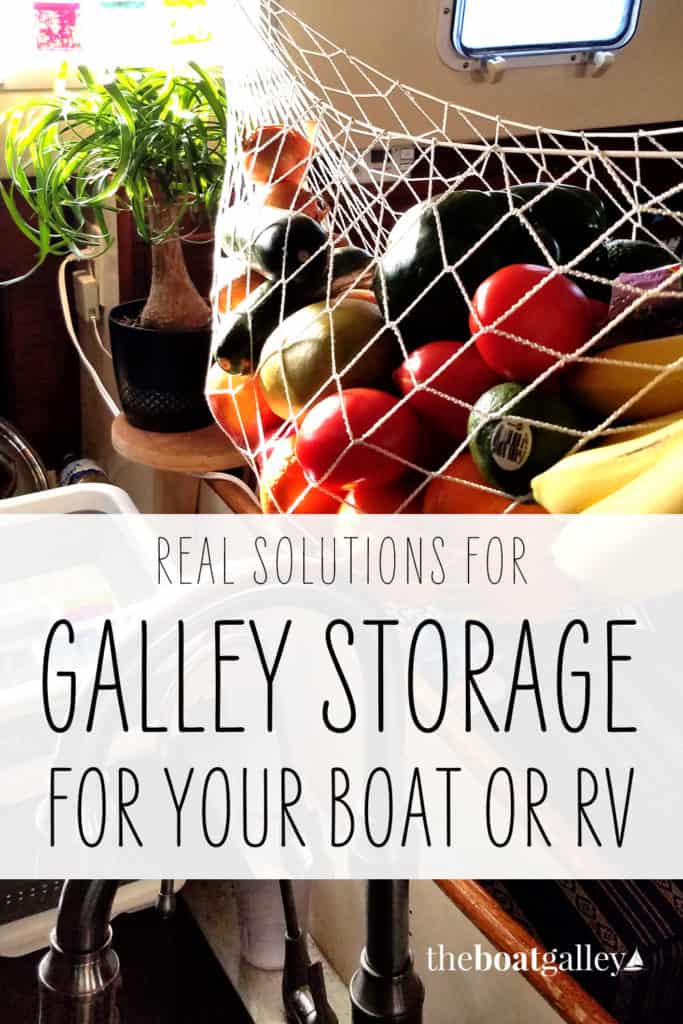
So what does galley storage really look like? A reader asked if I’d be willing to post photos of the inside of my lockers and cupboards so she could get a better feel for how storage really worked in a galley.
Sure, I can do that! Here’s a tour of my current setup, as it really is. No special straightening or cleaning. Obviously, every boat is different and every person will arrange things differently even on the same boat. But if you’ve never lived on a boat, it can be hard to visualize just how you’ll fit things in.
First, the layout of our boat with galley storage spaces marked. I’ll refer to the numbers here in my descriptions of the photos. Links in the descriptions go to articles I’ve written about specific items.
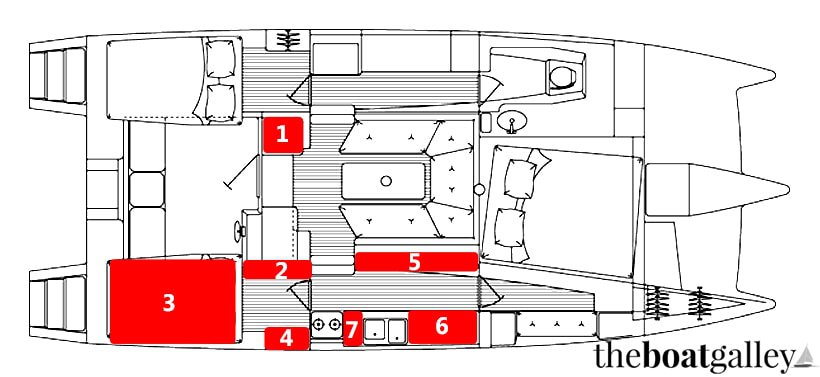
Galley storage area 1: Just inside the cockpit door is a low seat with storage inside (on later Geminis, this houses the air conditioning system). It’s top loading. Right now, it’s not full . . .
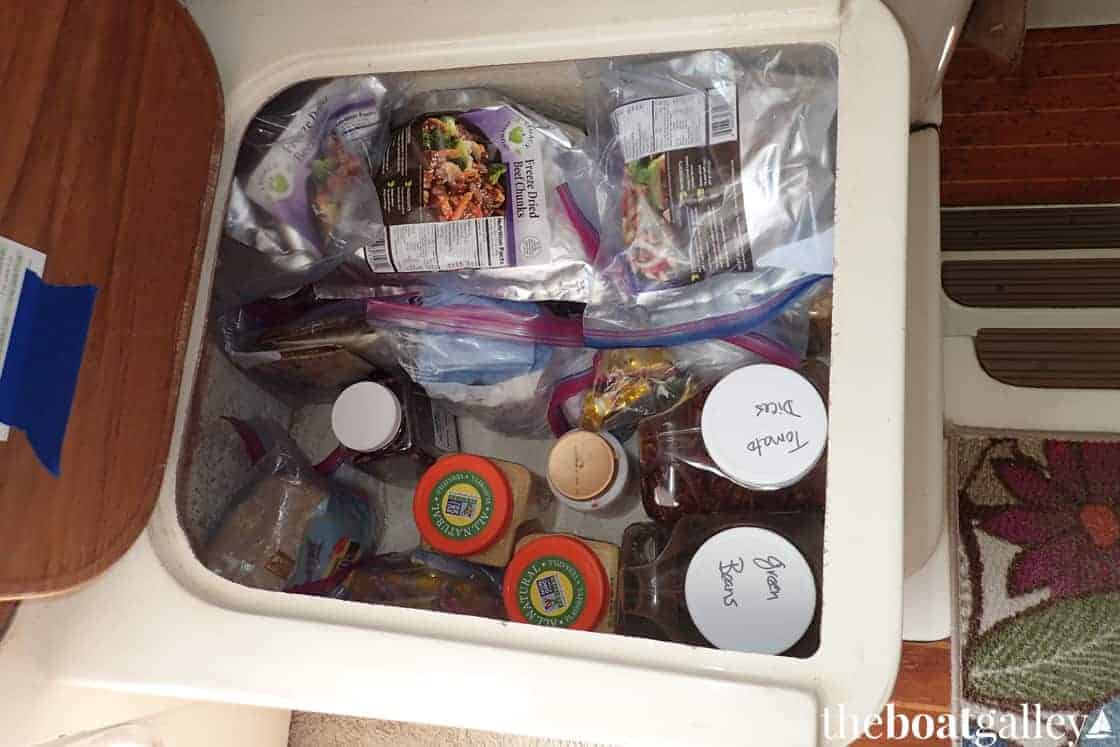
Galley storage area 2: A wall-mounted shelf unit with a large but shallow drawer underneath. When we get underway, I do a better job of securing the small containers — the shock cords work well. Paper towels here and trash/recycling bags underneath.
A very thin drawer underneath is perfect for milk boxes.
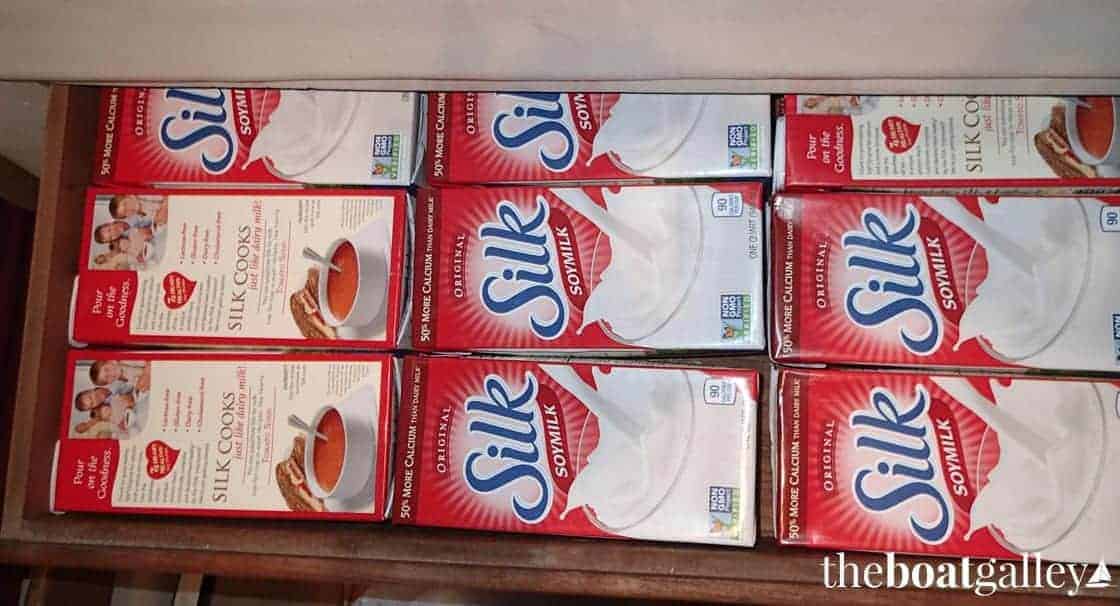
Storage area 3: A previous owner removed the cushions from the aft cabin; our watermaker is under the bunk and the front area has to be kept open for us to get to the water maker controls — underway, the bins of bread and produce now on top of our storage drawers get placed down on the front. The shopping bag on top contains rags. The water jug is on the floor because our water maker is not plumbed into the tank — we put the hose in the jerry jug and then transfer the water into the tank via the deck fill.
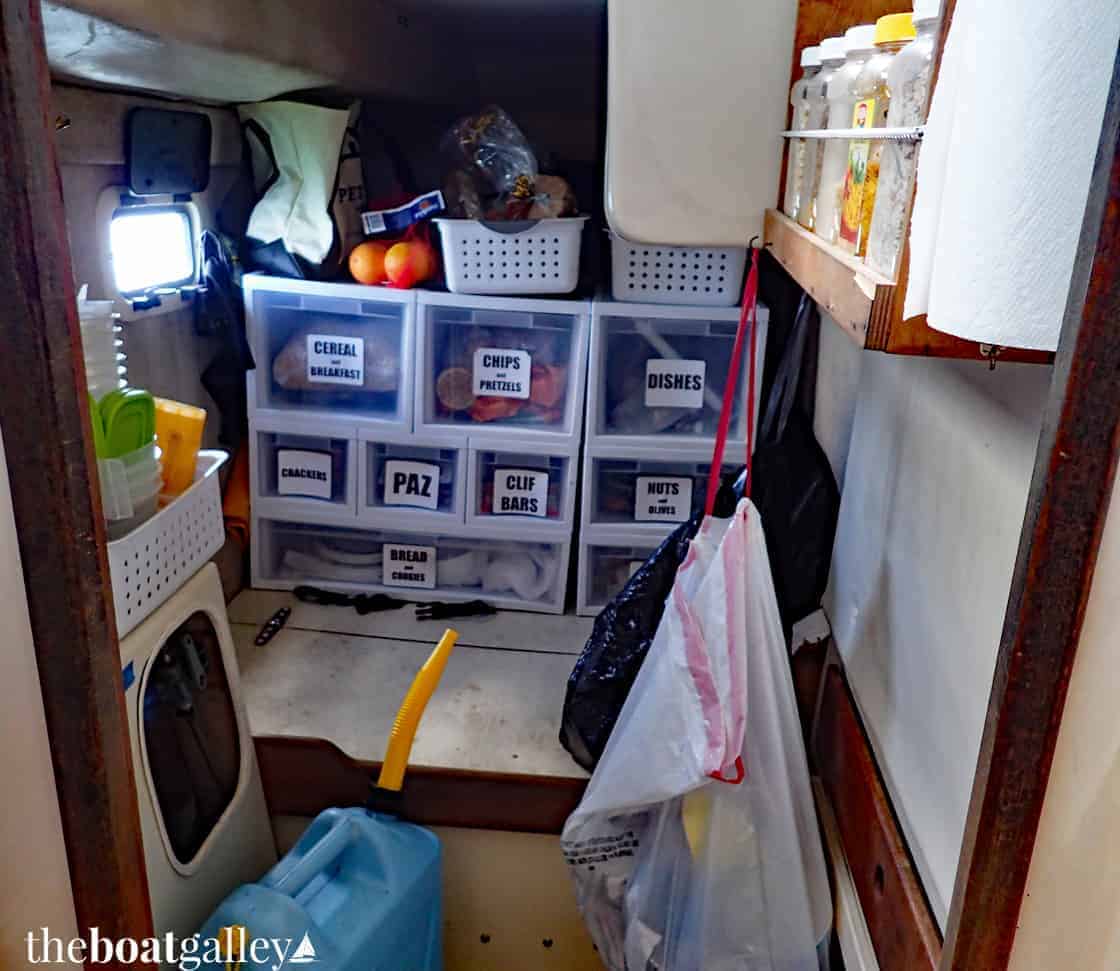
We have less accessible (long-term) storage bins behind. I have to be careful not to put too much stuff here as catamarans are weight-sensitive! I don’t show it in a photo, but I normally keep my shopping bags, dry bags and soft-sided provisioning cooler on top of the bins in the back.
Note: we do NOT use bottled water; what you see in the photo below is our emergency supply.
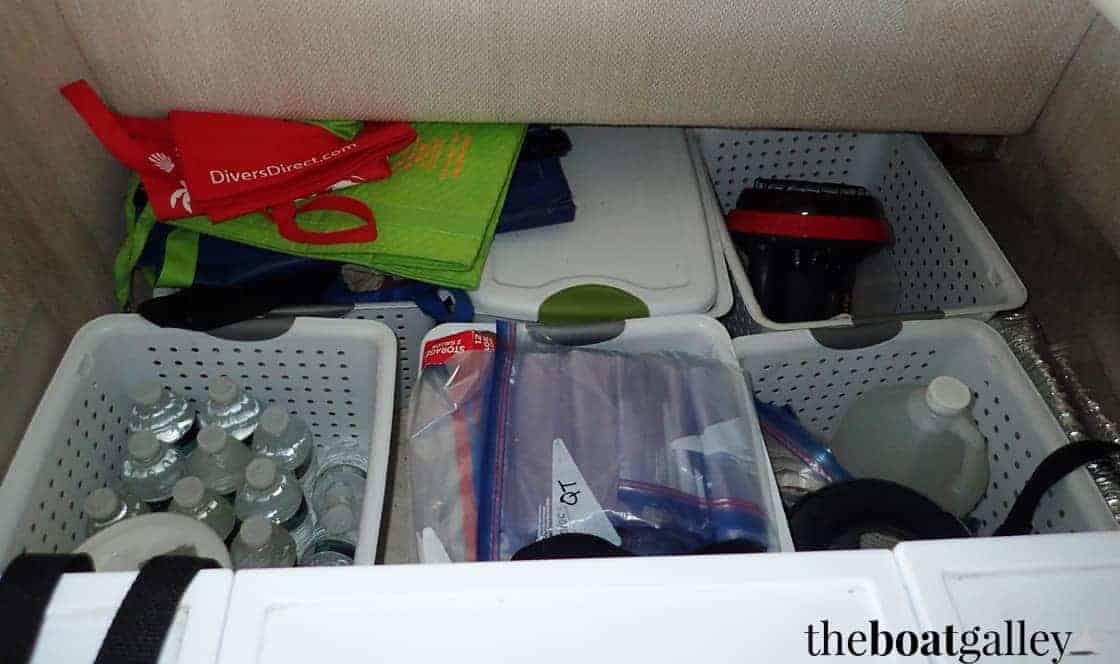
Storage area 4: Shelved storage with drink cans below. A hanging “sock” for grocery bags . Fire blanket on top of the shelves. A bin held in place with Velcro to hold food storage containers (most of my Lock & Locks are in use, these are extras for leftovers).
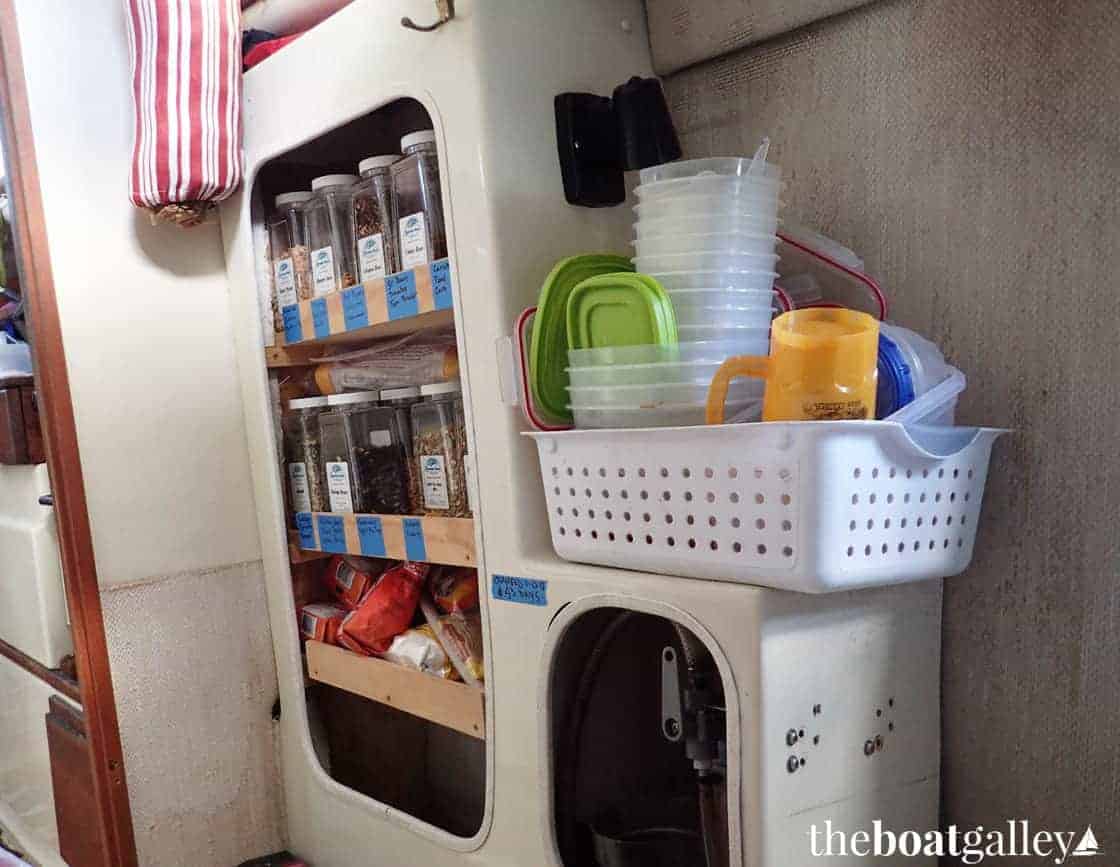
Storage area 5: Odd-shaped storage compartments with sliding doors above and below. First the two top areas.
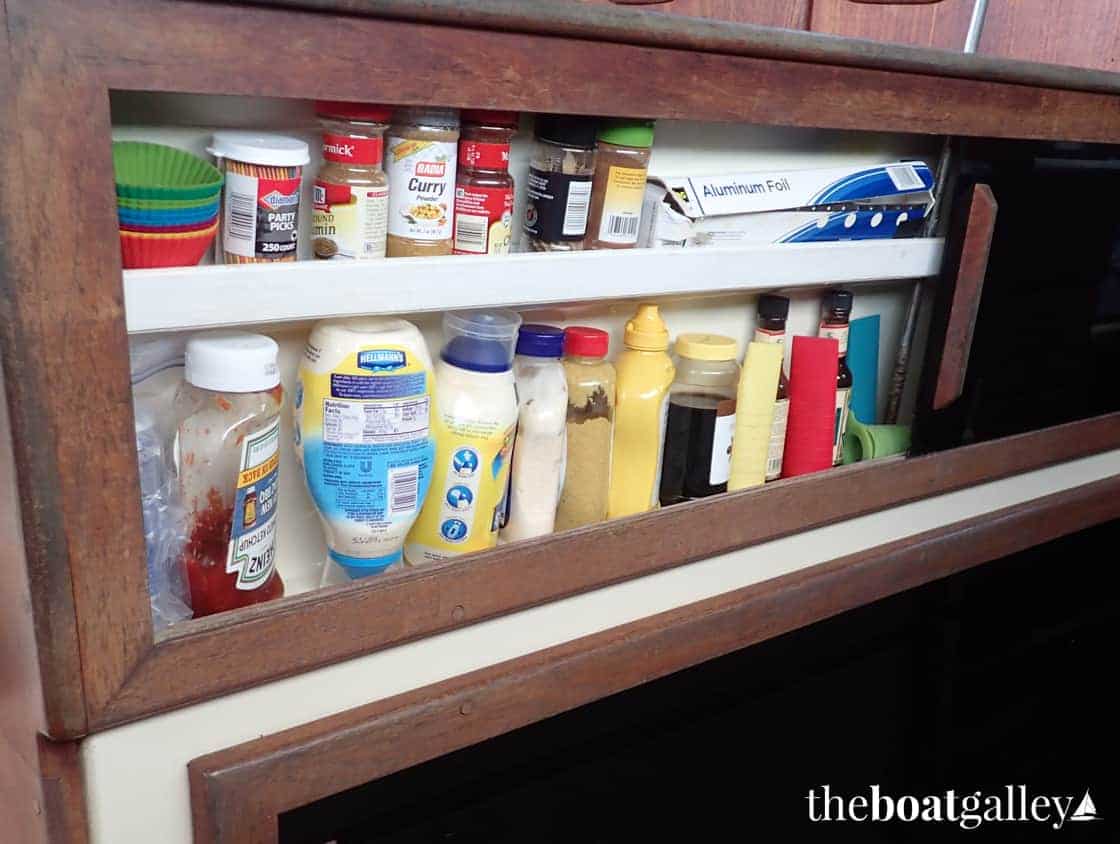
The aft lower one has baking supplies and cereal in front, and baking pans behind (if I’m baking, I already have the flour and sugar out, so it’s easy to get to the pans behind). And yes, I do have a couple of glass pans because they fit in my odd-sized oven. In summer (high humidity) and when we’re on the move, I use plastic bags over the Gatorade, Nido, and bottles on the bottom shelf.
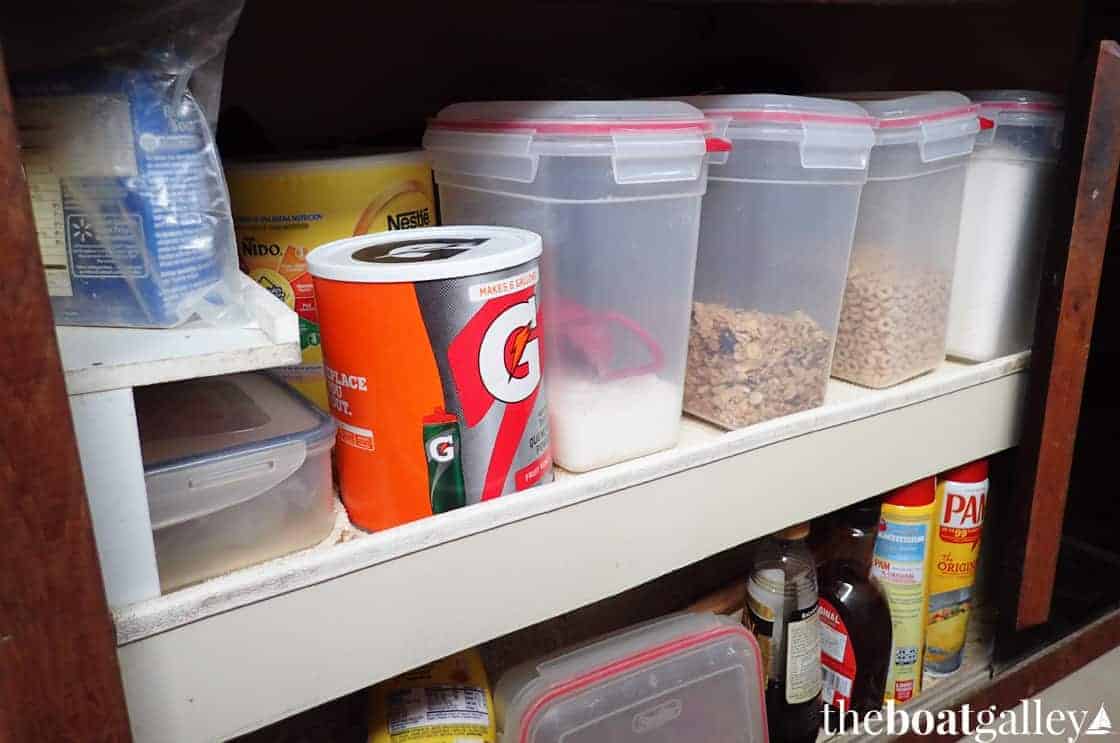
The forward area. In back is a bin for canned meats and I also store bags of dried beans, rice and so on, as well as my American Press coffeemaker , grilling tongs and our grilling sheet.
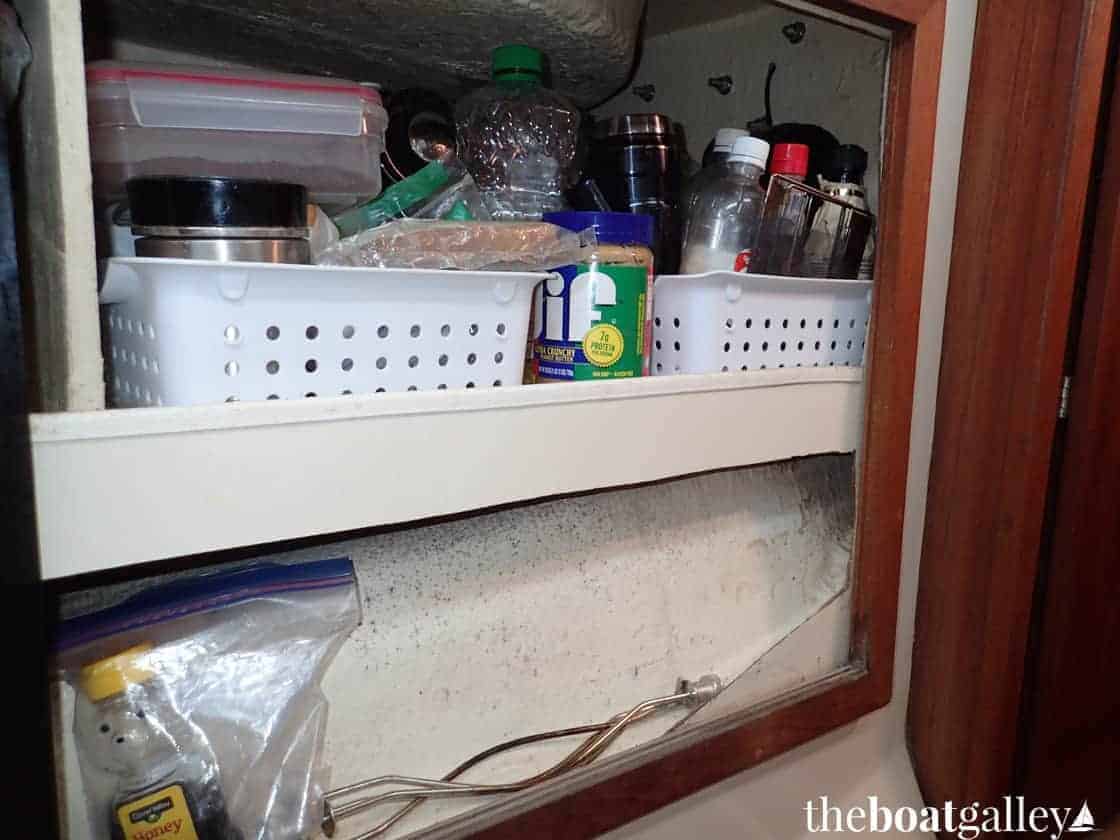
Storage area 6: All the way forward is a drawer for silverware. I keep a knife block on the counter (no, I wouldn’t do this on a monohull even at anchor; underway this gets laid down on our bed with a blanket around it so that knives can’t fall to the floor). Our drinking water filter and a second fire blanket are here.
There is a big top-loading storage area under the counter — this is my prime work space and dish drying area, so I use this for cleaning supplies instead of food. Actually, there is a lidded bin with some “hidden” snacks under the cleaning supplies that I fill when we are heading off on passage. It’s fun to have some extra treats!
Along the back of this counter is a very narrow shelf where I keep spices. Occasionally one falls into the sink underway, but that’s not a problem.
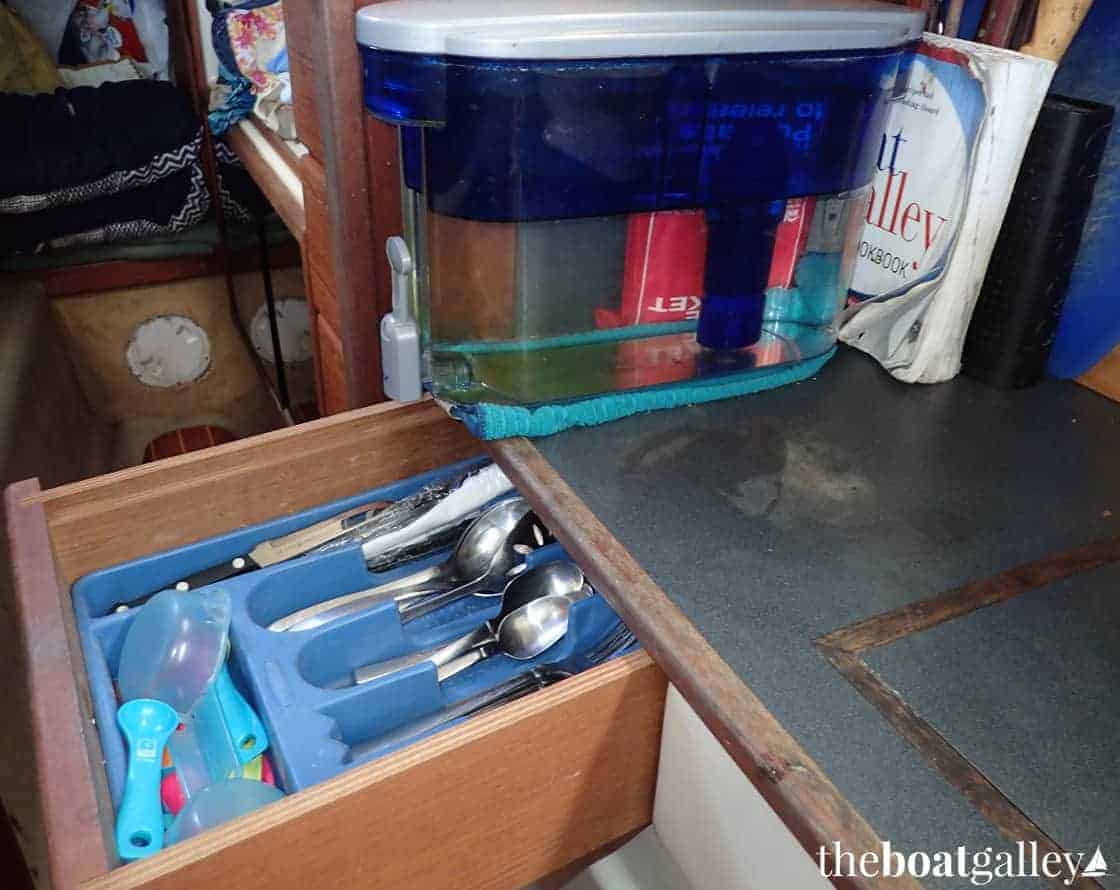
Underway, everything on the counter gets put into the sink.
Storage area 7: A small drawer next to the stove. I use it for cooking utensils . . . and really need to get rid of a few more things that the previous owner left! Under the stove is a small cupboard where I keep my nesting pans (due to the way it’s configured, I can’t get a good photo inside).
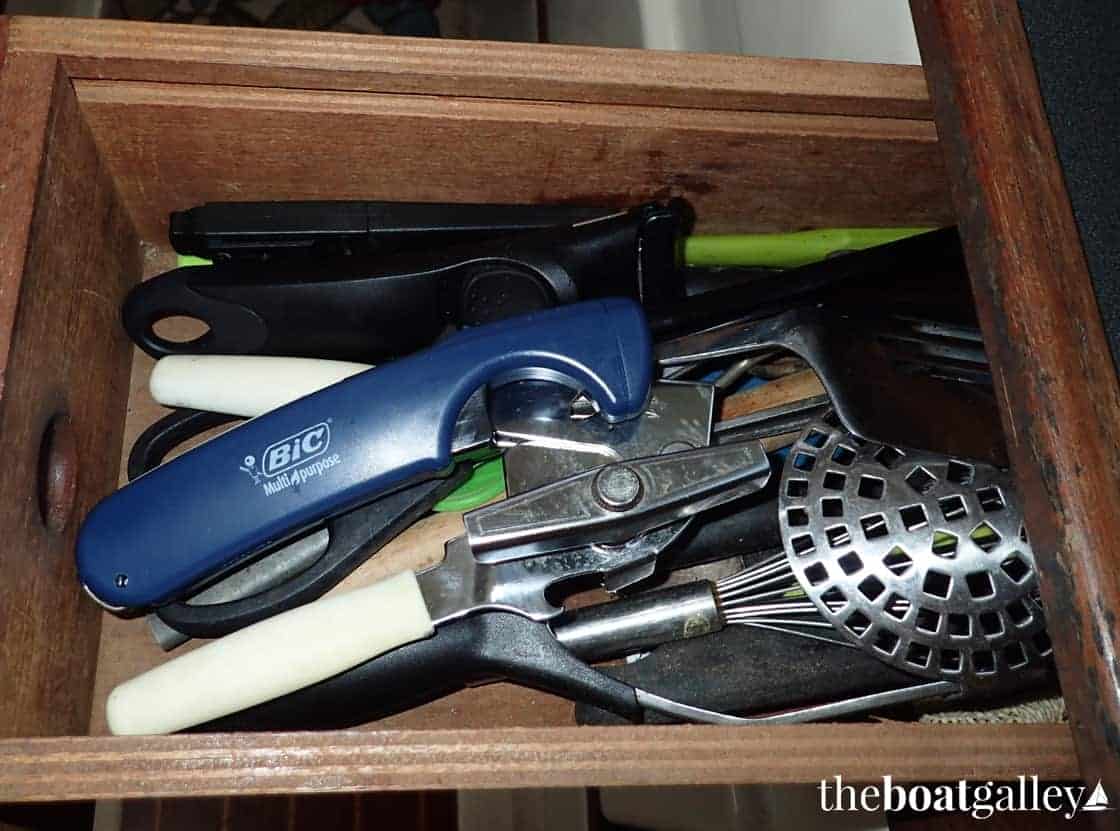
Overall, it works pretty well. On our previous boat, a monohull, most of the food storage areas were under and behind the settees, so my arrangement was somewhat different.
In top-loading lockers, it really helps to label the tops of containers. In deep compartments, I’ve found that it works best to put long-term stocks in back or on the bottom, with smaller containers for use now in the easier to reach areas.
And one final note: I’ve never found the “perfect” arrangement. I periodically rearrange my storage areas as we change locales and may get foods in different packaging — or get different food, period — and as our tastes evolve over time. Or I may just get fed up with something being difficult to get to!
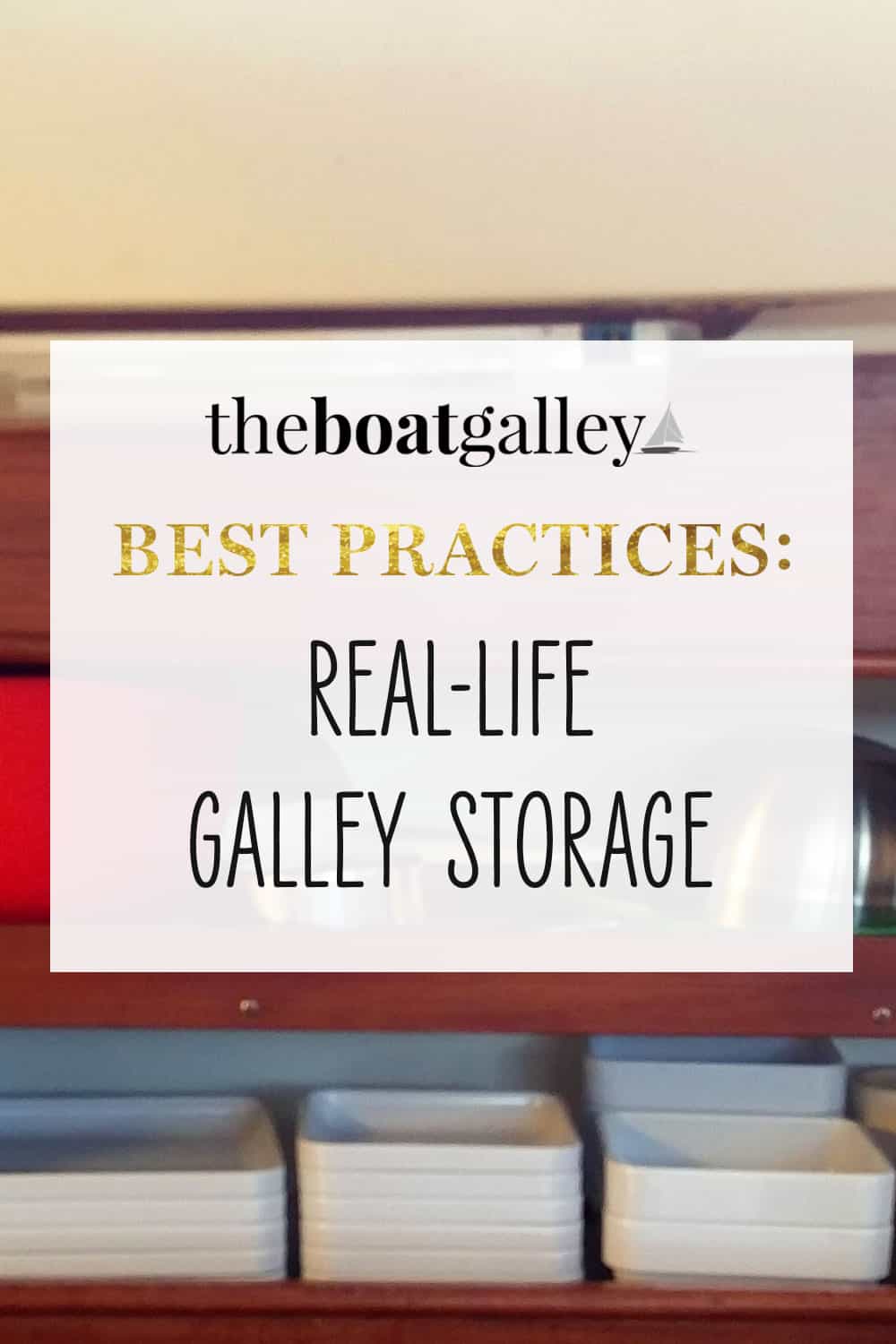
And check out our other courses and products
Find this helpful? Share and save:
- Facebook 466
- Pinterest 2.2K
Reader Interactions
Pamela Douglas Webster says
February 17, 2017 at 12:28 pm
Thanks. That was interesting.
Do you know a monohull owner who might be willing to share pics for a future post? I’d volunteer but I haven’t yet made the most of my galley storage since I’m in the ICW and can shop every week or two. 🙂
Jo-Anne Mason says
February 17, 2017 at 12:33 pm
I would be happy to do that but first I want to fit plastic bins in our closet. We have an old boat not tons of storage but I am making the best of it.
The Boat Galley says
February 17, 2017 at 1:14 pm
Let me see if I can find one . . . anyone here willing to share pics? If so, I’ll make them into a similar post. Need them to be about 1000 to 1200 pixels wide (if larger, not a problem).
Rosalind Franks says
February 17, 2017 at 4:19 pm
I don’t mind sharing some pics. I’ll send them to you tomorrow
February 17, 2017 at 4:46 pm
Many thanks — email to carolyn (at) the boat galley (dot) com (take the spaces out)
February 17, 2017 at 5:18 pm
The Boat Galley – will do
Brenda Tough Grimes says
April 30, 2018 at 10:58 pm
Hello there, I agree with a lot of the other comments I have read on this post as well as a few others I have checked out so far. A lot of great information and helpful tips Carolyn and followers. My husband Peter and I have a 34 ft RL monohull. Still sorting out our galley and storage compartments but this post and comments has confirmed that it is trial and error and later, try again.
Has Rosalind or Jo-Anne shared photos of their monohull? If so, where will I find them?
I love the shelf for cans in post below – I will be on the look out for that or something similar.
We also have an older style fridge/freezer which you store from top/down, so it is a learning process and looking for some plastic shelving or something to assist accessing bottom items without having to completely unload.
We also have a very peculiar shaped cupboard in the galley – like half a triangle, which I am trying to work out best way to utilise its space.
I will keep going through your posts Carolyn as I have already learned a few tips and look forward to learning lots more.
My husband Peter is a sailer and I am learning – I love the water and boating, but sheets and halyards and winches and tacking into the wind or going windward are terms that I am still learning.
Thanks again, Brenda, Lilac Wine
Carolyn Shearlock says
May 1, 2018 at 7:02 am
Yes, the pictures of monohull storage are here: Real-Life Monohull Galley Storage
Wow you have tons of storage I love it. I finally figured out the best way to store food in fridge, got some of those tall plastic food storage containers and put the same types of food in each. We have an old fashion in the hull fridge that is difficult to reach. Ice in a bin in the bottom so no leaks if we have a melt down. Working great so far.
February 17, 2017 at 3:13 pm
My biggest problem now is not to use all that space in the aft cabin! It’s easy to stuff it full and weigh the boat down.
Ann-Marie says
July 16, 2019 at 10:23 am
I really appreciate alll of your resources! We just moved onto our new-to-us Leopard 45. What is the best way to determine if you’ve put too much weight in a berth used for storage?
July 16, 2019 at 2:30 pm
Great question! The only way I know of is to look at your boat from the outside — at anchor and from a dinghy is best, but you can do it from a dock if you have an unobstructed view of the waterline. See if one side (port/starboard, bow/stern) is lower than the other. Make sure that you’re not below the manufacturer’s waterline anywhere. If so, you need to start rearranging so that the boat is floating evenly and at her intended waterline.
Terri Zorn says
February 17, 2017 at 1:43 pm
Thank you,thank you. You have no idea how helpful this will be,esp the photos. I just haven’t been able to get things “right”. You’ve shown some wonderful ideas.. #442
February 17, 2017 at 2:31 pm
Glad it helped!
Michelle Rene says
February 17, 2017 at 2:32 pm
Love this post!
Joysealife.com says
February 17, 2017 at 4:17 pm
I think we get used to everything looking like Better Homes & Gardens. Nice to see you keeping it real!
February 17, 2017 at 4:47 pm
Thanks. I notice so many pics that cannot possibly be of a boat that’s actually being used. But it was a reader who asked for it, so I can’t take credit for the idea.
Betina Lange says
February 17, 2017 at 12:32 pm
I know this has little to do with storage, but how come your water maker isn’t plummed into your tank?
February 17, 2017 at 12:56 pm
Previous owner did it that way, and it’s Katadyn’s recommendation so that you don’t accidentally get bad water into the tank. We’ve talked about plumbing it in, but it just hasn’t come to the top of the priority list!
Kristine says
February 17, 2017 at 12:55 pm
Fire blankets? Does everyone carry them except us? Are they for the obvious or some other use?
February 17, 2017 at 2:03 pm
Fire blankets often extinguish kitchen fires faster than a fire extinguisher and with a lot less mess. See my post: https://theboatgalley.com/fire-blanket/
cyndy carter says
March 3, 2017 at 1:14 pm
You can also use a fire blanket to lay across a blazing hot engine to close a through hull or tape up a leaky exhaust elbow or other emergency repair (quick and dirty until that engine cools down!) You can also wrap a person who’s clothing has caught fire and put it out FAST. It’s very difficult to “stop, drop, and roll” in a 2 1/2 by 3 galley. As a redhead with very tender skin…. lots of uses! I only have one but 2 might be a good idea! You may have covered all these things in your article but since I just 2 minutes ago made an amazon order that I linked thru the boat galley… including a new heat blanket…. LOL
Lori Steinbrunner says
February 18, 2017 at 12:22 am
Great post. Especially being a fellow Gem owner, it’s always nice to see how others use the same (or similar) space.
February 18, 2017 at 1:25 am
There’s no one way, is there? And even my arrangement has changed over time . . .
Dona Cantwell says
February 18, 2017 at 8:10 am
We find rearranging the galley is a constant shuffle. What seemed to work, eventually we find isn’t quite right. Still working and not cruising yet, we’re hoping to add storage in our galley steps. Has anyone done this yet?
February 18, 2017 at 8:32 am
I’ve met several people who have done this (it wouldn’t have worked on our previous boat as the steps exactly covered the engine). Basically, they’ve made the step so it’s on a hinge and opens upward.
Tory Fine says
February 18, 2017 at 3:01 pm
Wow it’s good to see this just to confirm we can’t possibly complete the typical provisioning lists with the room our boat provides, lol. It’s always boggled my mind when people come back with 3 carts of food as to where it would go! We have a 37 foot monohull and two cubbies behind our settee and a top loading fridge to store food. Maybe an eighth of the storage you have here. That’s it. But we’ve still done almost 2000 miles of cruising so it’s so true that you can cruise with any size boat if you plan accordingly!
February 18, 2017 at 4:37 pm
I actually was able to put MORE food on our 37-foot monohull — or at least more heavy cans. A previous owner had done some carpentry to make the under-settee areas into large lockers instead of small drawers (they glued the drawer fronts and cut access panels in the top under the cushions). And we used about half the quarterberth for bins with drink cans.
February 18, 2017 at 4:56 pm
The Boat Galley wow, crazy! It’s amazing what space efficiency some boats have!
February 19, 2017 at 12:23 pm
Actually, I think it’s a case of knowing how far it is to the next provisioning stop. I suddenly found more places to store stuff on this boat when we went to the Bahamas, and on the previous boat when we went to the Sea of Cortez . . . in both , we wanted to be able to go at least 3 weeks before restocking.
Julia Weeks says
February 21, 2017 at 8:18 am
Thank you so much for sharing this info – especially the photos. We have an older cat also – Richard Woods, and have been trying to figure out the best way to store provisions for longer hauls. I really like the way you turned the aft bunk into a pantry. I’m thinking of doing this as well and adding some plastic storage bins with drawers like you have done. I think that would make great use of a space that we rarely use, other than a catchall.
February 21, 2017 at 8:19 am
Glad it helps!
Julie OFlaherty says
February 21, 2017 at 9:57 pm
Hi Carolyn, I have learned a lot from your website and emails. I am not a boater, but an Airstream camper owner. I can recommend another great and inexpensive container for storage when ventilation of the contents is not a concern.
It is the bins designed to hold ice cubes in the door of a refrigerator. The cheaper ones from Big Lots are better than the more expensive ones, because they are a bit more flexible, and I have even trimmed the ends at the top to get them to fit just right in smaller areas.
I use them in several areas of our camper. They are good because they are narrow to fit in a lot of areas, but have fairly high sides to keep things from falling over. Great to hold spice bottles, coffee filters and a collapsible cone filter holder, CDs and DVDs in jewel cases, shampoo bottles in the bathroom, The solid bottoms contain any spills, and they hold a lot without taking a lot of room.
Just wanted to pass this along, as I appreciate all of the tips I have gotten from you.
February 21, 2017 at 11:04 pm
Thanks so much! There are a lot of similarities between boats and RVs — my parents had an Airstream Argosy back in the late 70’s and early 80’s.
February 22, 2017 at 8:46 am
I’m very jealous. We are moving on board our Gemini in July with 2 of our teenage sons. No port berth to use as a pantry and more stuff to store!
LeslieByrne says
February 23, 2017 at 9:59 am
We live on a 48 Selene trawler. Sailboats have way more storage.
February 23, 2017 at 11:19 am
And I’ve always been jealous of the space when I step on a friend’s trawler . . .
Coleen says
February 25, 2017 at 9:27 am

Christina Wagner says
October 12, 2017 at 1:53 pm
OMG your website is a big help!!! I love the website layout and how you explain stuff. Very easy to follow and you keep it interesting!! Not like the old men pages on boating. Pretty dry and dull. Thank you thank you!!
October 12, 2017 at 2:12 pm
That may just be my favorite comment yet! Thanks so much for brightening my day!
Anonymous says
April 18, 2018 at 7:48 pm
Carolyn, I really like the one sink on this pic. Is this your boat?
April 18, 2018 at 8:00 pm
Yes it is. A Gemini 105M. It’s a double bowl, but with one side much larger than the other. For me, dirty dishes (snacks between meals, etc) go in the small side and leave the “big sink” open for prepping the next meal.
April 18, 2018 at 11:03 pm
Yea I want all one sink but can’t find one like that.
April 19, 2018 at 12:17 am
Amy Roberts It came with our boat, and I haven’t seen one like it for sale for boats. However, I did have a house sink that was very similar so it the dimensions could work for you, that might be an alternative.
Leave a Reply Cancel reply
Your email address will not be published. Required fields are marked *
Each week you’ll get:
• Tips from Carolyn • New articles & podcasts • Popular articles you may have missed • Totally FREE – one email a week
SUBSCRIBE NOW
- Questions? Click to Email Me
- Visit Our Store


IMAGES
COMMENTS
The Boat Galley explores the liveaboard & cruising lifestyle. Decide if living on a boat is for you. Find detailed how-to's for your sailboat adventures.
Sep 17, 2012 · Cooking a great meal in a cavernous kitchen outfitted with every imaginable culinary device can be difficult enough, but doing it in the confined space of a sailboat presents greater challenges, some the result of ill-conceived galley layouts.
Jul 28, 2010 · It’s a thorough compilation of galley infrastructure and resources, materials choices, and galley hardware, from types of water tank materials to stoves, fuel, pumps, electrical requirements, as well as construction considerations.
Mar 19, 2021 · A perfect boat galley is well-designed, highly functional, and safe to use. Below, we cover everything you’ll need to know to make the most out of your space. The Boat Galley. Boat galleys vary in a ton of different ways. Size, layout, storage, proximity – the list goes on.
In this podcast, we break down your galley questions into three broad topics: And throw in some notes on pests, water, foraging, local food, food prep and waste disposal. Here are some time codes… 00:00 All about boat galleys. 02:49 What is a ship’s galley? 04:25 Galley layouts. 07:14 Provisioning for food on a sailboat. 07:46 Local food sources.
Apr 7, 2022 · After 30 years trying out various boat galley accessories, long-term cruising sailor Nica Waters offers her top recommendations for kitting out your sail boat's kitchen with a few tried...
A properly thought-out boat galley is a key component of an offshore cruising boat. So where should it be located, and what's the best arrangement for the individual galley components?
Sep 29, 2014 · The Boat Galley can be overwhelming with over 1,000 articles. We have four FREE mini-courses to guide you to just the info you need, whether you’re discovering what living on a boat would be like, preparing to cruise, overwhelmed with the first-year learning curve, or needing help with cooking aboard.
Feb 17, 2017 · What do galley storage areas on a boat look like in real life? A photo tour of the lockers on our boat just as they really are!
Sep 28, 2021 · Galleys that are U-shaped or are tucked into passageways like on the Hylas 56 sailboat, help keep motion contained so the cook doesn’t go flying.